Bulletin – August 2004 Statement on Monetary Policy
Download the complete Statement 773KB
Economic developments over recent months point to continued good growth of the Australian economy. The global upswing has maintained its momentum since the early part of the year and should provide an improving environment for Australian exporters. Business and consumer confidence are at high levels. At the same time, adjustment is occurring in the Australian housing market, which is no longer in the overheated condition seen at the end of last year.
The renewed pick-up in global economic growth has been underway for more than a year now and has become increasingly broadly based. The US recovery is firmly established, with business investment contributing strongly to the expansion along with consumer demand. With healthy employment growth over recent months, initial concerns about a ‘jobless recovery’ have faded. Core inflation in the US remains relatively low but has picked up noticeably since the start of the year, so that earlier concerns about the risk of deflation have also moved off the agenda. Reflecting the strong growth prospects for the economy and the pick-up in price pressures, the Federal Reserve has begun the process of normalising official interest rates from their historical low point, lifting the fed funds rate by 25 basis points to 1.25 per cent at its end-June meeting.
Other parts of the global economy are also enjoying strong or improving conditions. The Japanese economy is now in a solid expansion, recording its best conditions since the bursting of the asset-price bubble more than a decade ago. In China, growth has been exceptionally strong, prompting the Chinese authorities to take action to rein in overheated sectors of the economy. These measures have had some success in restraining growth but, even so, the pace remains very fast by the standards of any other country. Other parts of Asia are also showing continued economic strength, supported in most countries by growth in domestic demand as well as a continued rapid expansion of trade with China. The euro area economy, though still lagging the rest of the world, has shown further signs of improvement over recent months.
Against the background of the firming US economy, financial markets had fully anticipated the Fed's decision to raise official interest rates at its late June meeting, and the announcement passed largely without market reaction. With US interest rates still well below historical norms, markets expect additional tightening, and a further increase in the funds rate of 100 basis points is currently priced in over the next six months. Several other central banks – the Bank of England, the Reserve Bank of New Zealand and the Swiss National Bank – have also raised their interest rates recently. In Australia, market interest rate expectations remained broadly steady through this period, with markets assessing that Australian rates were closer to normal than in most other countries. The market continues to expect that Australia's cash rate will remain unchanged in the next few months but that some further tightening will occur in due course.
The exchange rate of the Australian dollar has remained in a range well below the peak reached earlier in the year. The main reason for this change in sentiment towards the Australian dollar was the growing prospect of US monetary tightening, and the expectation that it would mean a narrowing of Australia's interest differential against the US. In late July/early August the Australian dollar was trading around US70 cents, 12 per cent below its February peak, and 9 per cent down in trade-weighted terms.
The Australian economy is continuing to expand at a good pace. Consumer confidence is at its highest level in a decade and consumer spending has started to receive a significant boost from the additional benefit payments and tax cuts announced in the federal Budget. Business surveys are reporting better-than-average conditions and, with strong profitability and an improving international environment, the situation appears favourable to further expansion in business investment. Consistent with the general strength of the economy, the unemployment rate has trended down over the past year to around the lowest level seen over the past two decades.
The growth of the economy has for some time been driven by very strong growth in domestic demand, which has been partly offset by the external sector. With the international economy picking up, it has been reasonable to expect a gradual rebalancing of growth to get underway, involving a stronger export performance and less reliance on growth in domestic demand. To date, while the economy has maintained a strong pace overall, this rebalancing has been slow to materialise. There are, however, some indications that the economy is now benefiting from the global upswing. One mechanism for this has been the lift in global commodity prices and the associated improvement in Australia's terms of trade. In the March quarter the terms of trade were 10 per cent higher than a year earlier, and they are likely to have risen further in the June quarter. The resultant increase in incomes is one of the factors that have supported domestic spending growth.
In addition, it now seems clear that, after an extended period of weakness, the level of exports has passed its trough. At this stage, the pick-up in exports has been quite narrowly based. Much of it has been driven by the improvement in rural conditions and the recovery in international tourism, while resource and manufactured exports have been relatively flat. Factors that may have contributed to the subdued performance in these sectors include the appreciation of the exchange rate during 2002 and 2003, which may have dampened growth in manufactured exports in particular, and capacity constraints in the resources sector. However, these effects are likely to wane, with the exchange rate having been well below its peak in recent months, while the resources sector will benefit from the significant new capacity starting to come on stream this year. Hence, given a supportive global environment, there are good prospects that export growth will become more broadly based over time.
Australia's inflation rate in underlying terms remains relatively low. The June quarter CPI showed a rise in the annual inflation rate to 2½ per cent, from a rate of 2 per cent in the March quarter, but this movement largely reflected the effects of petrol price fluctuations on the year-ended calculation. Looking through the volatility, the various underlying measures suggest an underlying inflation rate of just over 2 per cent, which is down by around a percentage point from its recent peak. It is unlikely, however, that this will decline much further, if at all. At present, inflation is still being held down by the ongoing effects of the 2002–2003 exchange rate appreciation, but it can be expected to move higher in due course as those effects wane. While this has been broadly the expectation for some time, it now appears likely that the trough in underlying inflation will turn out to be somewhat higher than envisaged in previous Statements. The Bank's current assessment is that underlying inflation will remain close to 2 per cent for a little while longer, probably through to around the end of this year, and then start rising to around 2½ per cent by the end of 2005. Beyond that period, it could be expected to rise further if the current strength of domestically sourced inflation persists.
Developments in the housing market, and the associated growth in credit, have had an important bearing on assessments of the economic situation in the recent period. The overheating in the housing market last year carried the potential to destabilise the broader economy, the more so the longer it continued. There are clear indications, however, that the situation has now changed. After the rapid increases in house prices up to the end of last year, the available indicators suggest that prices declined in the first half of 2004. Auction clearance rates fell sharply around the turn of the year and have since remained well below average, suggesting vendors' price expectations are not being met. There has also been an easing in the demand for housing finance, particularly from investors, though this will need to adjust further if the growth of housing credit is to return to a reasonably sustainable pace. Although, at this stage, the fall in house prices and slowing in finance have been relatively modest, these trends are indicative of an easing in demand pressures in the housing market after the overheated conditions that prevailed last year.
In its policy deliberations over the past three months, the Board has taken into consideration the improving international environment, the easing in pressures on the domestic housing market, and the broader outlook for growth and inflation in Australia. The international situation is one in which interest rates in the major countries are likely to be increasing from their current abnormally low levels. Australian interest rates were never reduced to the extreme position adopted in a number of other countries, and there is no automatic reason that they will need to be moved up in line with the increases that are likely to occur overseas. On the other hand, with the policy stance in Australia still mildly accommodative, and the global economic environment likely to remain favourable to growth, it would be surprising if Australian interest rates did not have to increase further at some stage in the current expansion.
At present the Australian economy is continuing to experience a good pace of growth with relatively low inflation. The part of the economy that had been most prone to overheating in the recent period was the housing market and, as noted above, this is now in a process of adjustment. At the same time, it has become apparent that the restraining influence of the exchange rate on inflation has now reached its point of maximum effect, so that the underlying inflation rate can soon be expected to start increasing. This will need to be closely watched. At this stage, however, while growth prospects remain firm, the pick-up in inflation from its current trough appears likely to be quite gradual.
In these circumstances the Board decided at each of its three most recent monthly meetings to hold the cash rate unchanged. The Board will continue to monitor these developments, and will make such adjustments to policy as may be required to ensure that the conditions for sustainable growth with low inflation remain in place.
International Economic Developments
The international economy has strengthened further with most major regions now experiencing favourable conditions. The most notable improvement is in Japan where the economy is enjoying its strongest growth for a decade. Recovery in the euro area is more gradual but increasingly evident. Combined with continued strong growth in the US and east Asia, as well as in emerging economies in Latin America and eastern Europe, this points to an increasingly broad-based upswing in global growth. Overall, the latest Consensus forecasts are for world GDP growth to rise to 4.7 per cent in 2004 before easing a little to 4.3 per cent in 2005, which would be the strongest two years of growth since the late 1970s (Table 1).
| 2002 | 2003 | 2004 | 2005 | |
|---|---|---|---|---|
| Consensus forecasts (July 2004) | ||||
| United States | 1.9 | 3.0 | 4.5 | 3.8 |
| Euro area(b) | 0.9 | 0.5 | 1.7 | 2.0 |
| Japan | −0.3 | 2.5 | 4.2 | 1.8 |
| China | 8.3 | 9.1 | 8.7 | 7.7 |
| Other east Asia(b) | 4.7 | 3.7 | 5.6 | 4.9 |
| G7 | 1.2 | 2.1 | 3.6 | 2.9 |
| World | 3.0 | 3.9 | 4.7 | 4.3 |
|
(a) Aggregates weighted by GDP at PPP exchange rates unless otherwise specified
Sources: Consensus Economics; IMF; RBA; Thomson Financial |
||||
Given mounting evidence that the global recovery is now firmly in place, central banks around the world have begun to remove some of their earlier policy stimulus. The US Federal Reserve, the Bank of England, and a number of other central banks have lifted their policy rates in the past three months.
United States
Growth in the United States remains strong, with GDP expanding by 0.8 per cent in the June quarter, to be 4.8 per cent higher over the year (Graph 1). The composition of growth over the year has been broadly based, with consumption and investment both supported by highly expansionary monetary and fiscal policy settings.
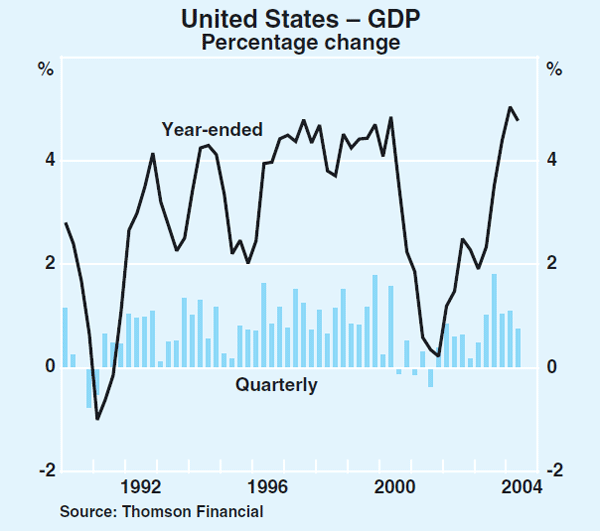
The labour market has continued to improve, with an average monthly rise in non-farm payroll employment so far this year of slightly above 200,000 (Graph 2). Encouragingly, the employment gains have been widely distributed across sectors of the economy, with manufacturing employment now rising again following three and a half years of persistent job losses, and the share of firms reporting increased hiring rising strongly to an above-average level. Forward-looking indicators point to further solid job creation. The ISM employment indices are at high levels, and initial jobless claims are at levels usually commensurate with monthly payroll rises of 150,000–200,000. These positive developments, however, come after a prolonged period of labour market weakness, and it is likely that considerable slack still exists. Consequently, the labour market should be able to continue to improve without placing undue pressure on labour costs.
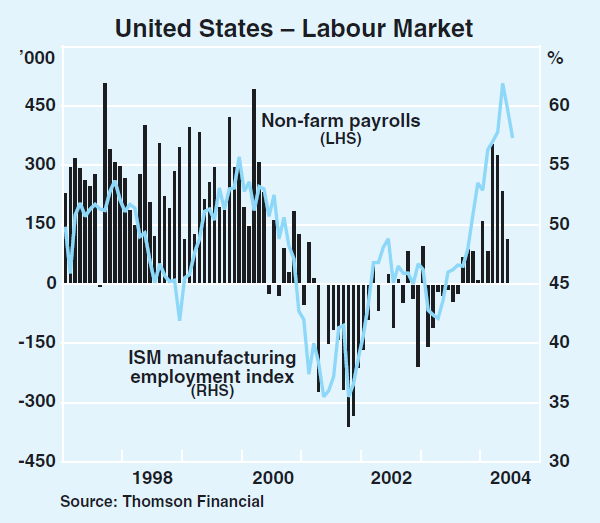
Consumption growth eased in the June quarter to 0.3 per cent, to be running at 3.4 per cent over the year. While the impact of tax cuts and child care rebates appears to have dissipated, it is likely that consumption growth will be supported by other factors, including the pick-up in consumer confidence (Graph 3), the improvement in the labour market, and household wealth, which has risen by 14 per cent over the year to the March quarter.
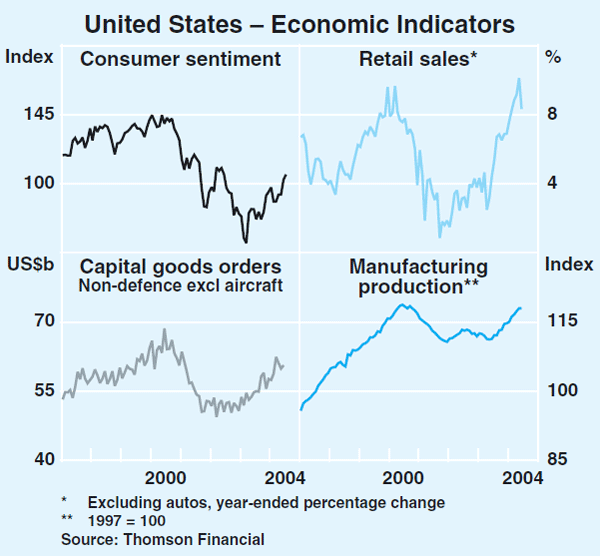
Conditions in the business sector remain positive. Business investment grew by 2.1 per cent in the June quarter, and is now 10 per cent higher over the year. Favourable financing conditions, accelerated depreciation allowances, rising capacity utilisation and strong business sentiment will lend support to business investment growth in the near term. Corporate gearing remains low, and corporate profits have risen by 28 per cent over the year to the March quarter, although some slowing in profit growth was evident in the March quarter. Growth in industrial production has remained firm and, with the inventory-to-sales ratio remaining at a record low, inventory rebuilding is expected to continue to contribute to near-term growth.
Recent inflation data in the United States have been signalling increased price pressures. CPI inflation stepped up to 3.3 per cent over the year to June (Graph 4). While much of this reflects transitory factors (such as higher oil prices), core CPI inflation has also picked up to 1.9 per cent over the year. Reflecting the solid outlook for growth and the pick-up in inflationary pressures, the Federal Reserve began the process of normalising interest rates by raising the funds rate by 25 basis points to 1.25 per cent in June, but noted that policy accommodation can be removed at a ‘measured’ pace.
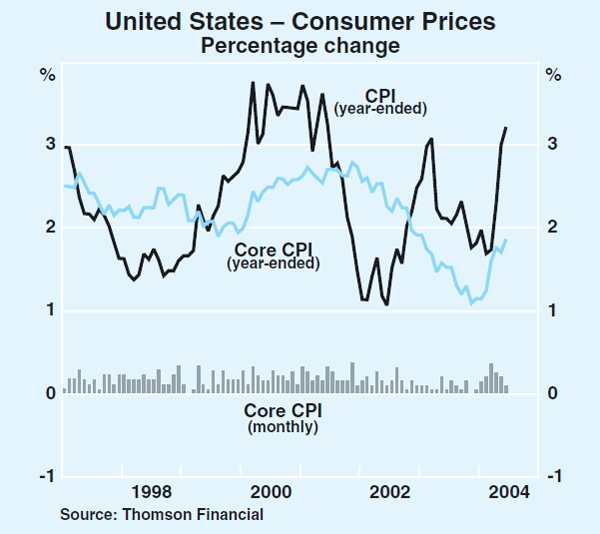
Asia-Pacific
Japan
Further positive news from Japan suggests that prospects for a sustained economic recovery are better now than they have been at any time since the bursting of the asset-price bubble more than a decade ago (see ‘Box A’ for further discussion). Japan's real GDP is recorded as growing by 1½ per cent in the March quarter and by 5.0 per cent over the year (Graph 5). Problems measuring the GDP deflator have probably resulted in this measure of real activity being overstated. Even so, nominal GDP growth has also picked up in recent quarters. Other more timely measures of activity, including industrial production and merchandise exports, also point to the strength of the recovery (Graph 6).

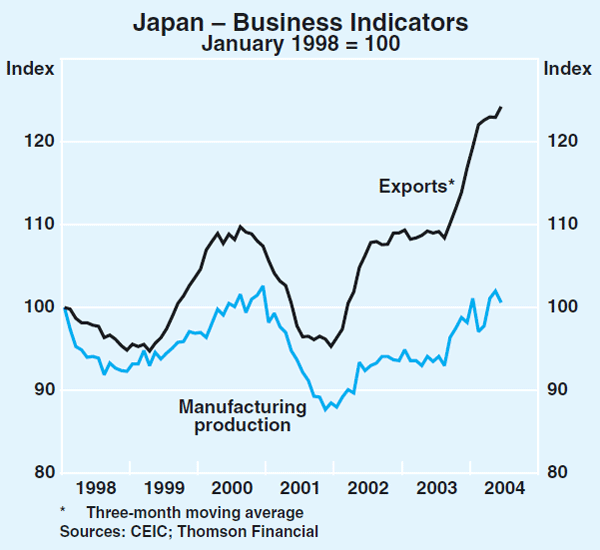
The corporate sector has been central to the current phase of recovery in economic activity. Corporate profits rose considerably over the year, with firms reporting that business conditions are at their strongest levels in 15 years or so (Graph 7). Business investment has now risen in each of the past seven quarters and was 14 per cent higher over the year to the March quarter. Much of the strength remains concentrated within manufacturing, keying off robust external demand (particularly from China), but conditions in the services sector are also improving.
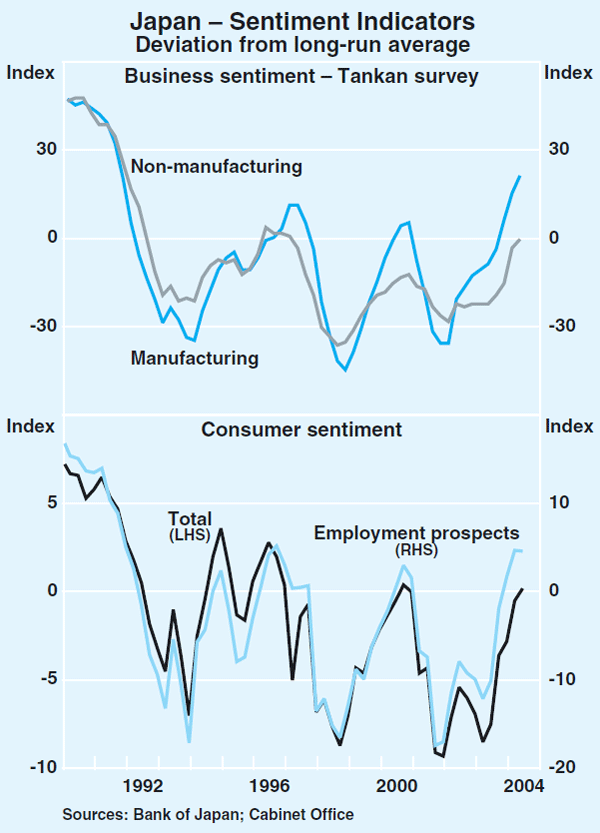
These developments have translated into a healthier labour market, with the unemployment rate having declined steadily over the past 18 months to 4.6 per cent in June. While much of this has been driven by declining labour force participation, associated with an aging population, employment has also picked up since late last year. Forward-looking indicators, such as the ratio of job offers to applicants, point to further near-term gains in employment. Improving employment prospects have helped to spur a recovery in household consumption and consumer sentiment (Graph 7).
The relative strength in domestic activity and rising commodity prices have driven up domestic corporate goods prices by 1.4 per cent over the year to June compared with average annual deflation of 1.0 per cent since the early 1990s (Graph 8). Final prices of consumption goods and services are still falling, and may continue to do so for a while yet given the considerable spare capacity in the economy, though the rate of decline has been easing. Consumer prices (excluding fresh food) fell by 0.1 per cent over the year to June, compared with rates of deflation of nearly 1 per cent during the past few years. Some, but certainly not all, of this improvement has been driven by temporary factors, such as rising rice prices (due to a bad harvest last year) and increases in tobacco taxes. The Bank of Japan appears committed to the current stance of easy monetary policy until consumer prices are seen to be rising over an extended period.
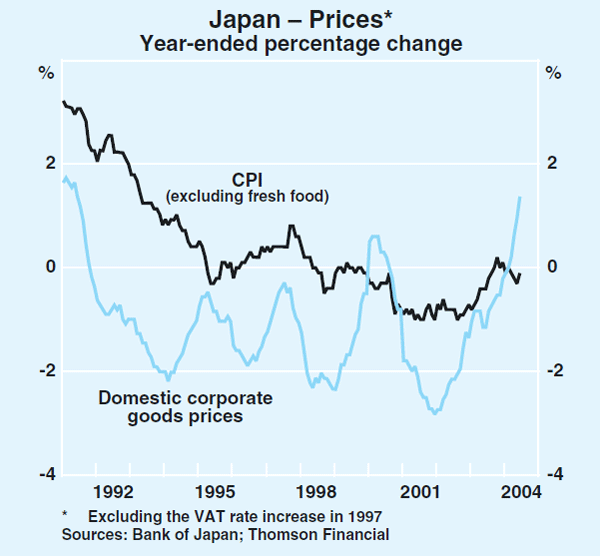
China
There are now signs that growth in China is slowing from the very rapid pace of recent quarters. This follows official measures aimed at reducing the growth rates of credit and money, restricting investment in industries that have been judged to have suffered overinvestment, and at the same time encouraging consumption, particularly among the rural population (see ‘Box B’ for further discussion).
GDP grew by 9.6 per cent over the year to the June quarter (Table 2). The Chinese statistical authorities do not produce data for quarterly growth, but some estimates suggest that this was around ½ per cent for the June quarter, compared with growth averaging about 3 per cent in earlier quarters. Growth in industrial production has slowed from a year-ended rate of 19.4 per cent in March to 16.2 per cent in June (Graph 9), and year-ended growth in fixed-asset investment has dropped sharply from 44 per cent in March to 23 per cent in June. This has been accompanied by an easing in the growth of the money supply and credit to around the government's targeted rates. Trade growth remains very strong with merchandise exports and imports growing by 47 per cent and 51 per cent, respectively, in the year to June. Similarly, household spending has been robust, with an acceleration in retail sales in recent months taking growth to 13.9 per cent over the year to June.
| December quarter 2003 |
March quarter 2004 |
June quarter 2004 |
Year to latest quarter |
|
|---|---|---|---|---|
| China | – | – | – | 9.6 |
| Hong Kong | 1.5 | 1.0 | – | 6.6 |
| India | 0.3 | 0.3 | – | 8.3 |
| Indonesia | 0.7 | 2.0 | – | 4.5 |
| Korea | 2.7 | 0.8 | – | 5.2 |
| Malaysia | 2.2 | 1.4 | – | 7.6 |
| Philippines | 1.5 | 2.2 | – | 6.2 |
| Singapore | 2.7 | 2.7 | 2.2 | 11.7 |
| Taiwan | 1.5 | 1.3 | – | 6.2 |
| Thailand | 2.5 | 0.8 | – | 6.6 |
|
Sources: CEIC; RBA |
||||
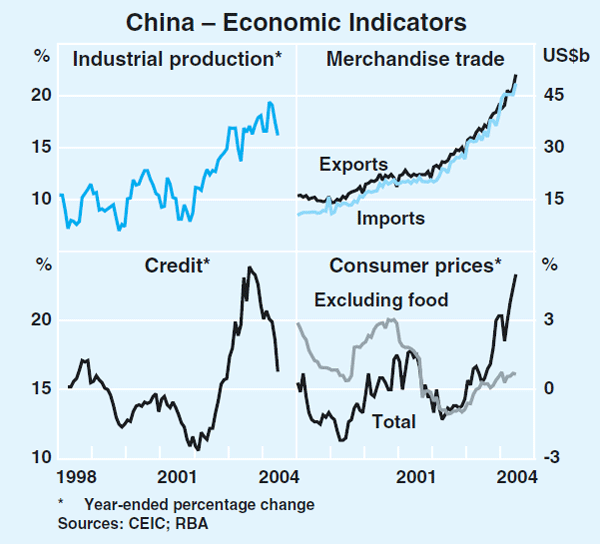
Consumer price inflation has edged up further in recent months, reaching 5.0 per cent over the year to June. This was largely due to higher food prices, which rose by 14.0 per cent over this period, partly reflecting adverse seasonal conditions rather than more broadly based inflationary pressures. Higher commodity prices have also contributed to strong increases in corporate goods prices over the past year, although the latter fell by 0.3 per cent in June – the second consecutive monthly fall – suggesting that upstream price pressures may be abating.
Other Asia-Pacific
Economic growth across the rest of east Asia remains healthy, notwithstanding signs of slowing in China, which has been a significant driver of export growth for the region. The overall strength of global economic activity and rising demand for ITC goods are stimulating rapid export growth across the region (Graphs 10 and 11). In addition, domestically sourced growth is making an increasing contribution as the region benefits from stimulatory macroeconomic policies and improving labour markets. Inflation for the moment remains low across most of east Asia, although inflationary pressures appear to be building.
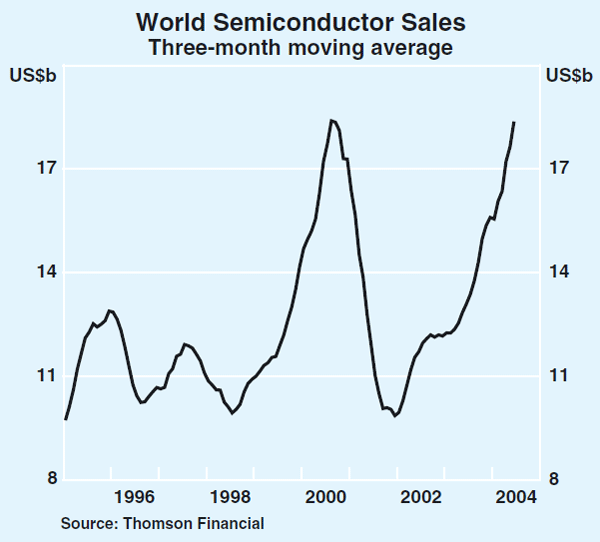
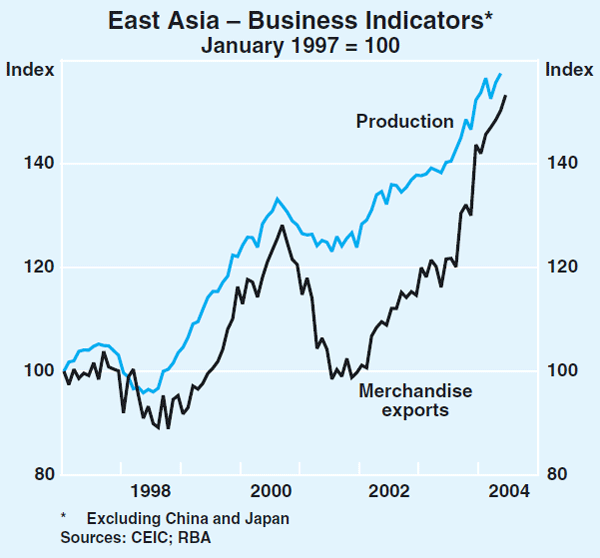
Aggregate GDP in east Asia grew by almost 6 per cent over the year to the March quarter. Growth was especially strong, and above long-term average rates, in Hong Kong, Malaysia, the Philippines and Singapore (Table 2). Growth continues to broaden to domestic demand, which rose strongly over the year. The main exception to this is Korea, where growth has been driven almost entirely by net exports.
Recent indicators suggest that the solid pace of growth in the region has continued into the June quarter. Industrial production and exports continue to expand at a brisk pace, rising by 14 per cent and 26 per cent, respectively, over the past year. Export growth has been strongest in those countries with the highest trade intensity with China. And while slower growth in China would, therefore, be expected to dampen export growth for the region, there are indications that domestic demand will still continue to grow strongly. In particular, retail sales and investment are rising strongly in most countries, propelled by improving labour markets, low interest rates and rising capacity utilisation rates (which are now back to levels last seen prior to the Asian financial crisis). Korea remains the main exception to this, with consumer spending still being dampened by excessive household debt.
Inflation remains low across much of east Asia, but is on an upward trajectory (Graph 12). Rising food prices associated with poor harvests have been a feature in most countries in the region. However, measures of upstream prices indicate that inflationary pressures are increasing more broadly, underpinned by rising capacity utilisation and high commodity prices. The Monetary Authority of Singapore and Bank Indonesia have already begun tightening monetary policy in response to these pressures.
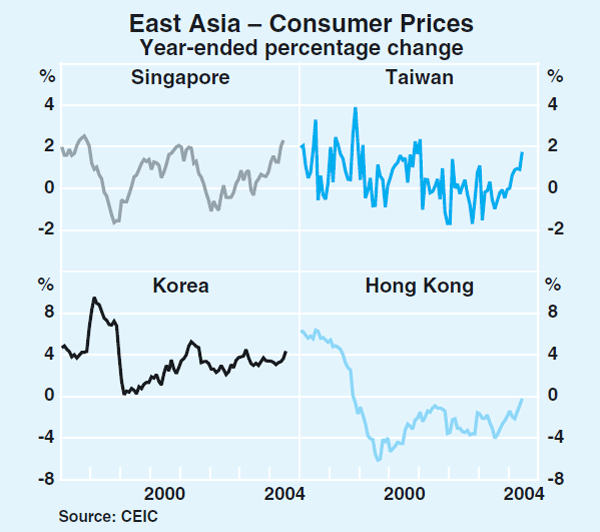
In India, GDP growth fell to relatively low levels in recent quarters, although it remained high over the year to the March quarter at 8.3 per cent. While growth of industrial production slowed over the three months to May, it remains on a consistent upward trend, and exports are growing strongly, rising by 35 per cent over the year to June.
The New Zealand economy continues to grow strongly. GDP expanded by a much stronger-than-expected 2.3 per cent in the March quarter to be 5.0 per cent higher over the year. Domestic demand was again the key driver of growth, rising by 8.9 per cent over the year. Although exports have recovered in the past two quarters, net exports remain a drag on growth. The strength of the economy has contributed to tight labour market conditions, with the unemployment rate currently at an historic low of 4.3 per cent. Over recent quarters the pass-through of the earlier appreciation of the New Zealand dollar has helped to mask the impact of rising inflation in the non-tradables sector. Citing these domestic price pressures, and the strength of activity more generally, the RBNZ raised the cash rate by 25 basis points in June and again in July to reach 6 per cent.
Europe
The recovery in the euro area has been much less pronounced than elsewhere, though conditions are improving. Euro area GDP expanded by 0.6 per cent in the March quarter, the strongest quarterly outcome since March 2001, to be 1.3 per cent higher over the year (Table 3). Much of the growth in the quarter was due to higher exports, with domestic demand growth still weak. Household consumption posted a solid increase in the quarter, although it appears to have been driven by tax cuts at the start of the year in some countries and does not seem to have been sustained into the June quarter.
| December quarter 2003 |
March quarter 2004 |
Year to March 2004 |
|
|---|---|---|---|
| Euro area | 0.4 | 0.6 | 1.3 |
| – Germany | 0.3 | 0.4 | 0.7 |
| – France | 0.6 | 0.8 | 1.7 |
| – Italy | 0.0 | 0.4 | 0.8 |
| – Spain | 0.7 | 0.6 | 2.8 |
| – Netherlands | 0.6 | 0.7 | 0.7 |
| United Kingdom | 1.0 | 0.7 | 3.4 |
|
Source: Thomson Financial |
|||
Aggregate euro area figures mask divergent trends across countries. Among the larger economies, France is performing relatively well, recording its third successive quarter of above-trend growth in March, propelled by solid gains in consumption and investment. Conditions remain much weaker in Germany and Italy, where there are few signs of an upturn in domestic demand.
More recent data generally point to a continuing modest recovery in the June quarter, again driven by external demand. Surveys report relatively upbeat conditions in the business sector for both manufacturing and services (Graph 13). Industrial production has risen steadily in recent months, to be 3.8 per cent higher over the year to May. The upward trend is stronger for merchandise exports – which have risen by 10.6 per cent over this period – and business surveys suggest that exports will remain strong in the near term.
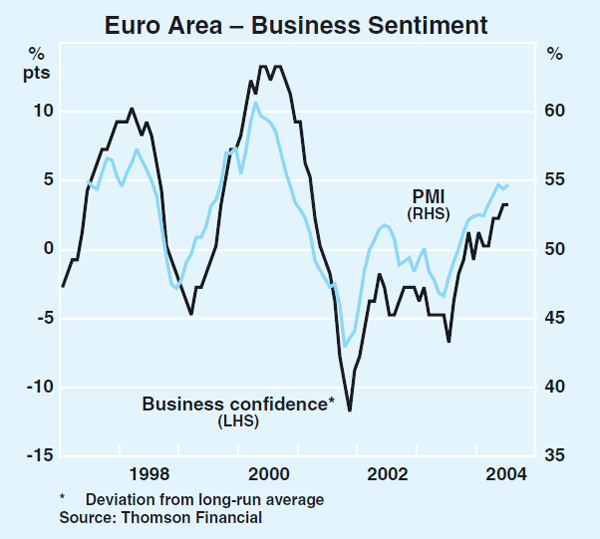
Soft labour market conditions and low confidence among consumers continue to hamper consumer spending. Retail sales have slipped back in recent months after a gain in the March quarter, with particular weakness evident in Italy and Germany (Graph 14). Having been steady at 8.9 per cent for the previous year, the unemployment rate nudged up to 9.0 per cent in April and has since remained at this level.
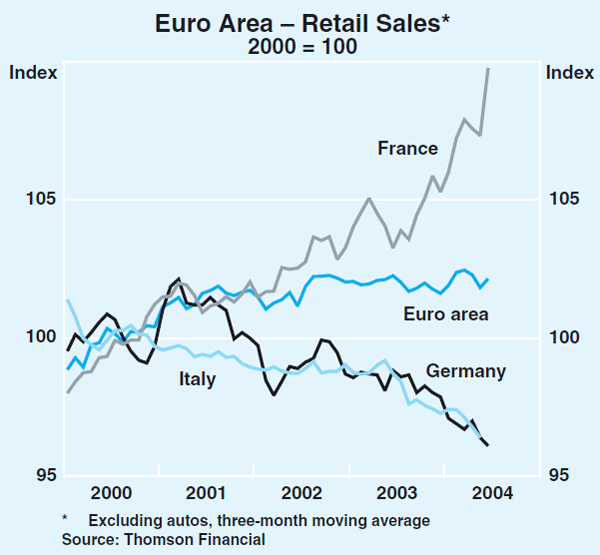
Higher oil prices in recent months have pushed inflation above the ECB's 2 per cent target. Underlying measures of inflation, however, remain around 2 per cent (Graph 15). The growth rate of labour costs has continued to moderate to be around 2½ per cent over the year to the March quarter, reflecting the weakness in the labour market. The ECB has held its policy rate steady at 2 per cent since June 2003.
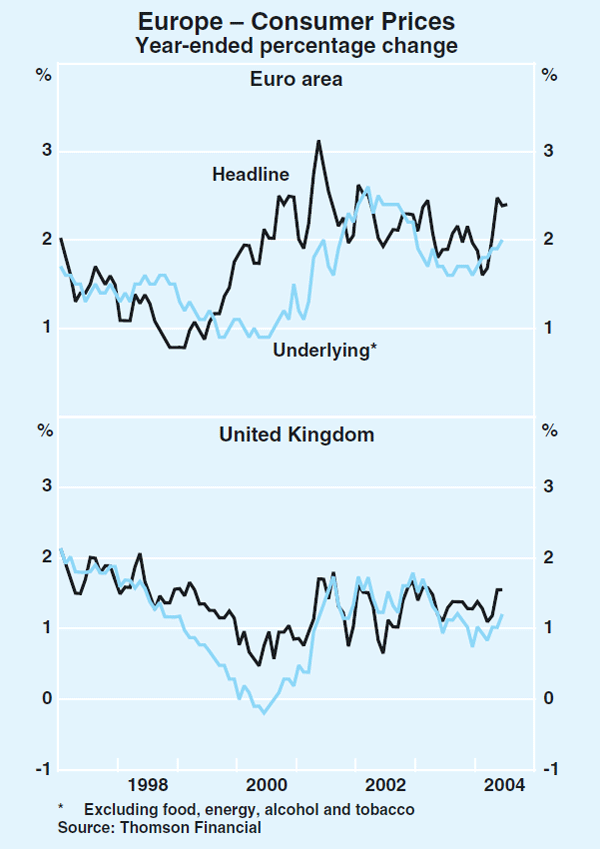
The United Kingdom is in its twelfth year of economic expansion and growing strongly. In the June quarter, GDP rose by 0.9 per cent to be 3.7 per cent higher over the year. Consumer spending continues to lead the way, with retail sales up by 7.2 per cent over the year to June. Investment has also risen strongly, supported by robust growth in corporate profits, as has manufacturing production. The unemployment rate is at an historically low 4.8 per cent. The pace of house price growth began to rise late in 2003, and has reached year-ended rates of over 20 per cent in recent months. Consumer price inflation has edged higher, primarily due to energy prices, to a year-ended rate of 1.6 per cent in June. The Bank of England raised its policy rate by 25 basis points in May and again in June to reach 4.5 per cent.
Oil price developments
The strength of global economic activity has underpinned rising demand for oil, with prices in US dollar and SDR terms remaining above the peaks seen over the past few years (Graph 16). As well as the broader strength of global economic activity, the particular strength of both the US and China has also played a role in pushing up oil demand given that these economies are relatively intensive in their use of oil. In addition to rising demand, concerns about the security of oil supply, following disruptions in Iraq and potential interruptions in Nigeria and Russia, have added upward pressure to oil prices. While OPEC's decision at the beginning of June to increase production quotas appears to have had a dampening influence on prices, they remain high, at over US$40 per barrel in early August.
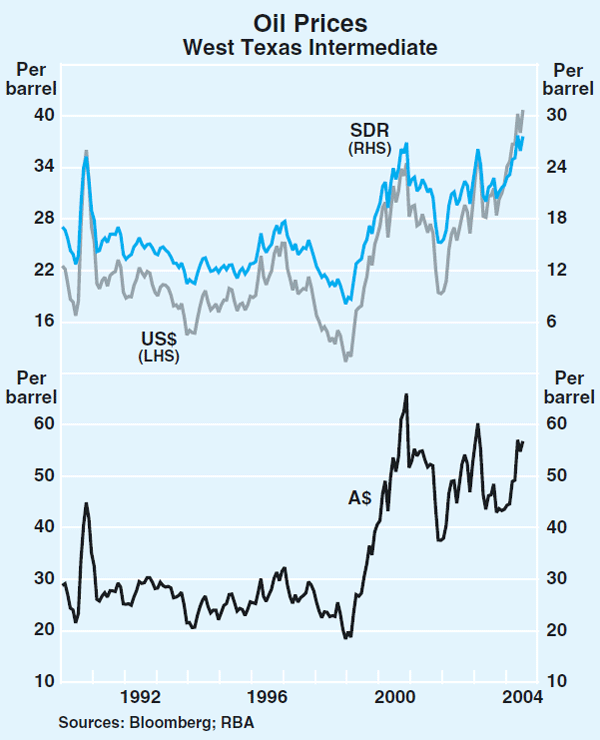
Box A: Corporate Recovery in Japan
The current period of growth in Japan is the third cyclical upswing since the bursting of the asset-price bubble in the early 1990s. The two previous upswings, in the mid and late 1990s, proved to be short-lived, with ongoing balance-sheet stress weighing on the performance of Japanese businesses. It is not possible to predict the course of the current upswing but there are a number of signs that the prospects of a durable recovery are better now than they were on the two previous occasions. One indication of this is that, unlike the brief episodes of growth in the 1990s, the current expansion is more broadly based and less reliant on public expenditure. Instead, it is being driven by a combination of private consumption, business investment and exports. The current period of growth has been characterised by improved conditions in the corporate sector, where profits increased by 20 per cent over the year to March 2004, reflecting strong external demand and greater efforts to control costs. This compares with an average annual decline in aggregate profits of nearly 3 per cent between 1990 and 2002. Firms (including larger financial institutions) are also better placed to withstand future shocks given the ongoing progress in balance-sheet repair.
One of the important elements of the corporate restructuring process over the past few years has been the reduction in labour costs. This has been achieved by significant labour shedding, as firms overturned the traditional system of full-time and lifetime employment (Graph A1). Most notable has been the 30 per cent decline in manufacturing employment since its peak in 1992 – a fall that is twice the magnitude of the decline in the US and the euro area over the same period. Aggregate employment has also declined over this period, though by a much smaller amount. Associated with this, there was a sharp slowing in the growth of labour compensation, further helping to contain costs. Compensation per employee in real terms had still been rising consistently up to 1998, but since then the trend has been relatively flat. There are signs, however, that labour market conditions are improving during the current economic expansion, with aggregate employment rising since late last year and a steady decline in measures of excess labour.

Another key element of the corporate restructuring process has been the increased repayment of outstanding debt. Notwithstanding the adverse impact of deflation, the ratio of corporate debt to GDP has fallen from a peak of 116 per cent in 1995 to 89 per cent – its lowest level since 1987 (Graph A2). Coupled with the reduction in interest rates and the recent recovery in profits – which are up about 40 per cent since their recent low in late 2001 – this has brought the debt-servicing burden down from a peak of 77 per cent of operating profits in 1993 to 17 per cent in the March quarter 2004. Still, corporate leverage remains high by international standards and further adjustment is likely, especially among the more highly geared smaller non-manufacturing firms.

Balance-sheet restructuring is also apparent within the banking sector, particularly with regard to non-performing loans. Despite a decline in the level of bank lending, official estimates suggest that non-performing loans have fallen from a peak of 8½ per cent of bank lending in 2002 to a little under 6 per cent, the result of a decline in new non-performing loans, and disposal of existing non-performing loans. Bank profitability has also risen, following a rise in the valuation of equity holdings, lower loan loss provisioning and further reductions in operating costs. Even so, considerable scope remains for improvement, with core operating profitability relatively weak (at only 0.8 per cent of assets for the major banks).
While the Japanese corporate sector has made significant progress in cleaning up its balance sheet in recent years, there remain impediments to the restructuring process. In particular, generalised deflation persists, though its pace has eased, and property prices are still falling. Data from the Japanese Real Estate Institute show that land prices nationwide fell by about 8 per cent over the year to the March quarter. As land remains an important component of collateral, this continues to discourage banks from lending. Nevertheless, there are a few tentative signs of a turnaround in the property market, including a rise in equity prices of real estate companies relative to the overall share market.
International and Foreign Exchange Markets
Money and bond yields
In late June the Federal Reserve increased the federal funds rate by 25 basis points from its 45-year low of 1 per cent. The move was widely anticipated and had little impact on financial markets. Rather, the pace of further monetary tightening in the US remains the primary focus of international financial markets, given the still highly accommodative stance of monetary policy. Pricing in futures markets suggests that market participants currently expect the Federal Reserve to increase interest rates by 100 basis points over the next six months (Graph 17).
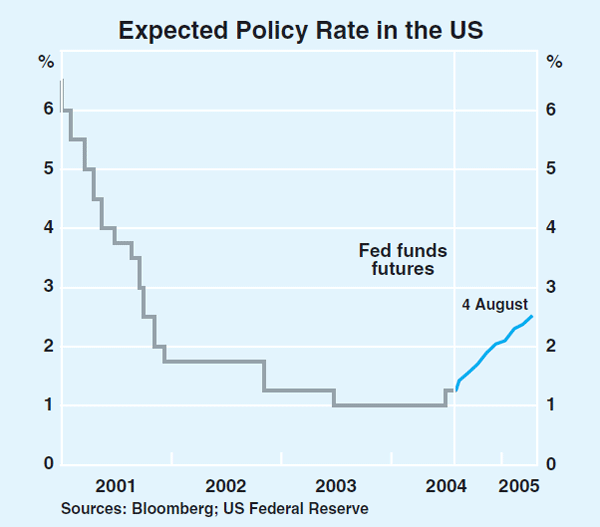
Financial markets do not expect the monetary authorities in the euro area or Japan to change policy rates in the foreseeable future. In Europe, expectations of further cuts have dissipated in recent months, as the economic news has improved slightly. In Japan, despite the robust economic recovery seen in recent quarters, consumer prices have continued to fall modestly. Given that the Bank of Japan (BoJ) has stated that it will maintain highly stimulative monetary policy until inflation becomes consistently positive, financial markets see little prospect of an increase in interest rates in Japan until the second half of 2005 at the earliest.
The Bank of England (BoE) and the Reserve Bank of New Zealand (RBNZ), the two central banks that followed the RBA in the tightening cycle, have continued on this path (Graph 18, Table 4). The BoE increased its repo rate by 25 basis points in both May and June, to reach 4.5 per cent, and has signalled that it expects to increase rates further over coming months. The RBNZ increased its official cash rate by 25 basis points in both June and July to 6 per cent and also indicated that further increases are likely to be needed over the year ahead. In its first move in the current cycle, the Swiss National Bank raised its target 3-month Libor rate in June, to 0.5 per cent from 0.25 per cent, where it had been since March 2003.
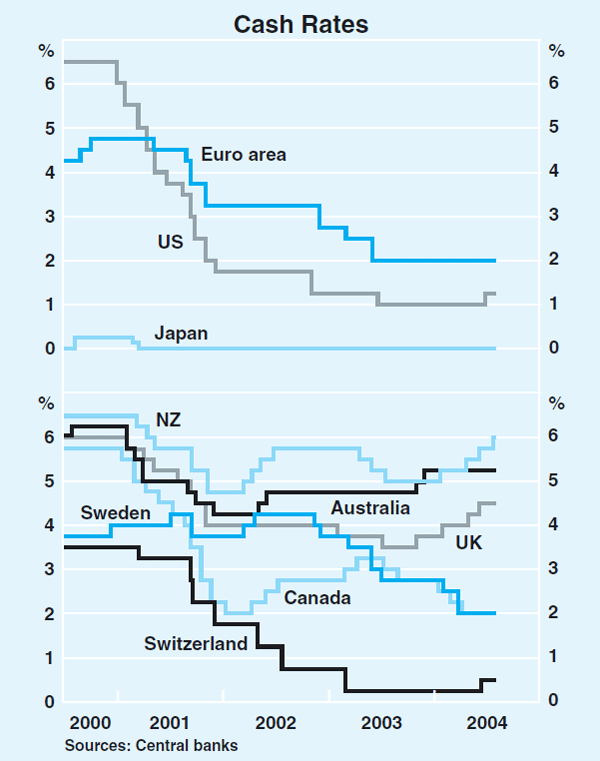
| Cumulative reductions in easing cycle Basis points |
Changes in policy rates Basis points |
Current level Per cent | ||
|---|---|---|---|---|
| From low point |
Since Jan 2004 |
|||
| US | −550 | +25 | +25 | 1.25 |
| Canada | −375 | – | −75 | 2.00 |
| Switzerland | −325 | +25 | +25 | 0.50 |
| Euro area | −275 | – | – | 2.00 |
| UK | −250 | +100 | +75 | 4.50 |
| Sweden | −225 | – | −75 | 2.00 |
| Australia | −200 | +100 | – | 5.25 |
| NZ | −175 | +100 | +100 | 6.00 |
| Japan | −25 | – | – | 0.00 |
|
Sources: Central banks |
||||
The Hong Kong Monetary Authority raised interest rates in line with the US Federal Reserve, as a result of its currency board arrangement. The Chinese authorities have implemented a number of financial measures to slow the pace of financial intermediation in an attempt to address their concerns that the Chinese economy is overheating (see Box B). Elsewhere in Asia, the generally low level of interest rates has been maintained, notwithstanding strong economic growth throughout the region. Policy rates were unchanged in Latin America over the past three months.
Yields on government bonds continue to be driven by expectations about the path of US monetary policy. While the Federal Reserve's tightening in late June had relatively little immediate impact on the government bond market in the US, yields have nonetheless continued to be heavily influenced by any information which might have a bearing on the future path of Federal Reserve tightening. Economic data released in the first part of July, which was a little weaker than the market had expected, caused yields to fall to a low of 4.35 per cent. Yields rose again following comments by Dr Greenspan and, at 4.45 per cent currently, are around 70 basis points higher than their March 2004 low and 130 basis points above their low in mid 2003 (Graph 19).
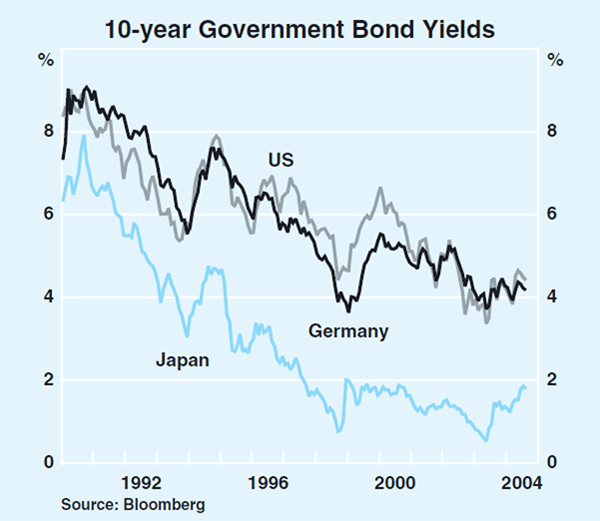
Developments in the US have continued to exert a strong influence over day-to-day movements in European bond yields, although given the relatively subdued outlook for economic activity in Europe, the movement in European yields has tended to be more muted. German government bond yields are marginally higher than at the time of the last Statement.
Over the past year, the largest rise in yields has been in Japan, reflecting the extent of improvement in growth, which was largely unexpected. Yields on 10-year government debt rose sharply in June, peaking at 1.9 per cent – the highest level since September 2000 – as the flow of strong Japanese economic data continued and confidence in the sustainability of the economic recovery grew. Yields are currently around 140 basis points above their mid-2003 low.
The behaviour of credit spreads provides further evidence that the policy tightening in the US has, thus far, been digested relatively smoothly by financial markets. US corporate and emerging market sovereign spreads relative to US Treasuries both remain near historical lows despite the late June tightening. US investment grade corporate and B-rated junk bond spreads have risen only modestly since the last Statement (Graph 20), while spreads on the less credit-worthy C-rated junk bonds narrowed by around 40 basis points.
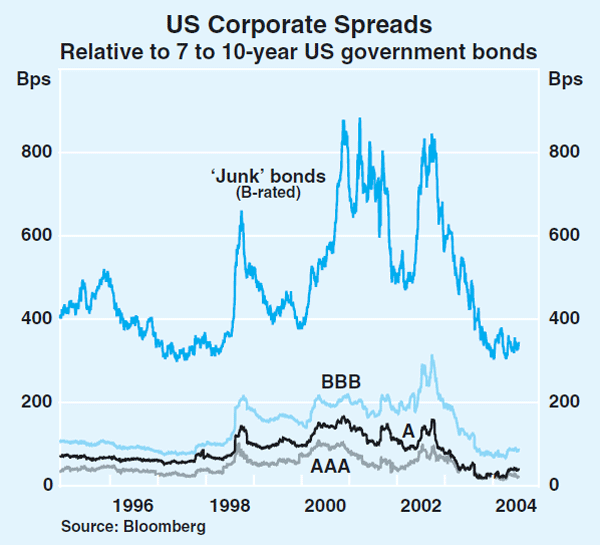
Spreads on emerging market sovereign debt widened by around 160 basis points in late April and in early May as the market began to focus on the impact of rising US interest rates on emerging market economies, but have since reversed around two-thirds of the increase. Overall, emerging market spreads are around 80 basis points higher than their low point at the start of 2004, but are still at historically low levels (Graph 21).
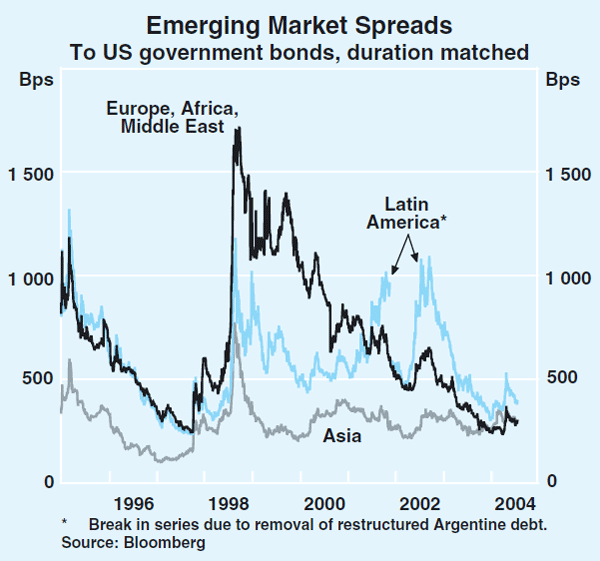
Equity markets
The major global equity indices are generally little changed since the beginning of this year, as markets weighed the implications of robust economic and profit growth against the prospect of a sustained monetary policy tightening in the US and higher oil prices (Graph 22, Table 5). In the US the S&P 500 is down around 2 per cent over the past three months and is approximately flat for the year. This is despite continued strong growth in corporate profits – the national accounts measure of earnings increased by 28 per cent in the year to the March quarter, while the profit share remains near cyclical highs. In the euro area the Euro STOXX is down 3 per cent over the past three months and is also flat in 2004. Despite the recent flatness, the S&P 500 is 37 per cent above its March 2003 trough, while the Euro STOXX is around 48 per cent higher than its trough.

| Change since 2000 |
Change since 2003 trough |
2004 to date |
|
|---|---|---|---|
| United States | |||
| – Dow Jones | −14 | 35 | −3 |
| – S&P 500 | −28 | 37 | −1 |
| – NASDAQ | −63 | 46 | −7 |
| Euro area | |||
| – STOXX | −48 | 48 | 0 |
| United Kingdom | |||
| – FTSE | −36 | 35 | −1 |
| Japan | |||
| – TOPIX | −36 | 46 | 8 |
| Canada | |||
| – TSE 300 | −27 | 34 | 2 |
|
Source: Bloomberg |
|||
Valuations in the US share market continue to be high relative to historical benchmarks. The P/E ratio for the S&P 500 remains around 20, compared to a long-run average of 15 (Graph 23). Other than in the current episode, the S&P 500's P/E ratio has never been sustained above 20 for more than around three years, with previous periods above 20 followed by a significant correction in equity prices.
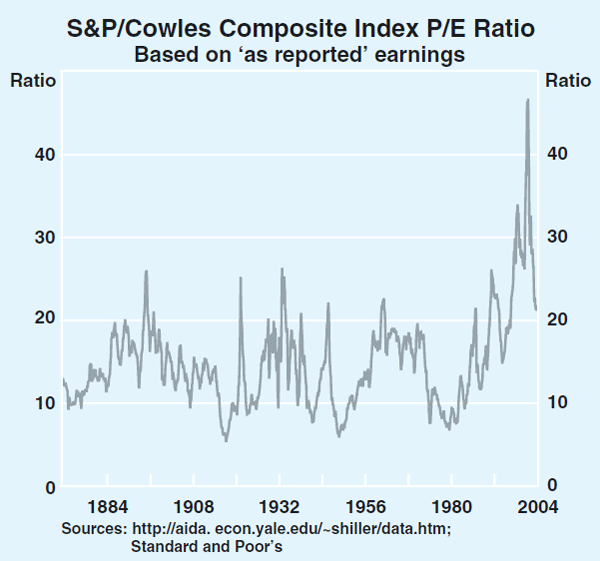
Asian equity markets have been more volatile than those in the US and Europe in 2004. The Japanese Topix has fallen by 5 per cent over the past 3 months, but is up 8 per cent so far this year, and is around 46 per cent higher than its 2003 low, in line with the economic recovery. Non-Japan Asian share prices have fallen 3 per cent on average over the past three months. Reflecting concerns about the extent of the prospective slowdown in the Chinese economy and the effect of rising US interest rates, average equity prices in mainland China and South Korea have fallen by 16 per cent over the past three months. Share prices in India have declined by 9 per cent since the last Statement, amid concerns about a possible slowdown in the pace of reform under the newly elected government. On average Latin American share prices have performed better than other markets over the past three months, rising by 7 per cent.
Exchange rates
The US dollar has moved in two phases over 2004 (Graph 24). After falling in the previous two years, the dollar appreciated by 6 per cent on a trade-weighted basis from January through to mid May, as greater confidence in the US economic recovery and the increasing likelihood that interest rates would rise supported the currency. However, in mid May the uptrend in the US dollar stalled and the currency has subsequently depreciated by around 2 per cent. This turnaround predominantly reflected the softer-than-expected data in the US for the month of June, which reduced expectations about the future pace of monetary tightening. Overall, the US dollar is around 11 per cent lower than at its peak in early 2002, although in real effective terms it remains around 4 per cent above its long-run average.
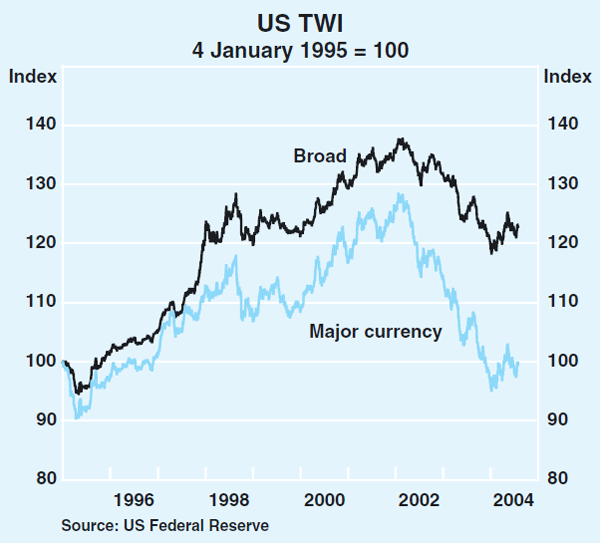
Movements in both the euro and the yen have mainly reflected developments in the US dollar over the past three months (Graph 25). After falling to 1.18 against the US dollar in mid May, the euro has since risen by 2 per cent. Similarly, the yen reached a trough at 114 per US dollar in mid May, before appreciating by 3 per cent more recently.
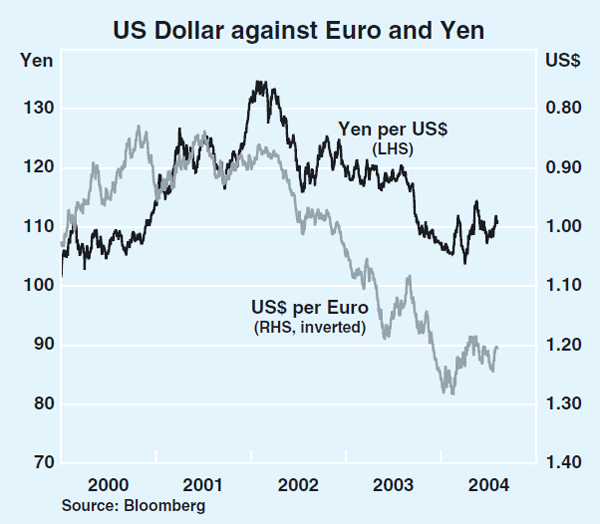
Non-Japan Asian exchange rates were relatively stable against the US dollar on average over the past 3 months (Graph 26). The rapid pace of reserve accumulation by many Asian central banks has eased in 2004, in part reflecting the appreciation of the US dollar over this period. The Indian rupee and the Indonesian rupiah were among the most volatile of the regional currencies, as a result of uncertainty surrounding their respective elections. Exchange rates in Latin America have also generally been relatively stable against the US dollar since the last Statement.
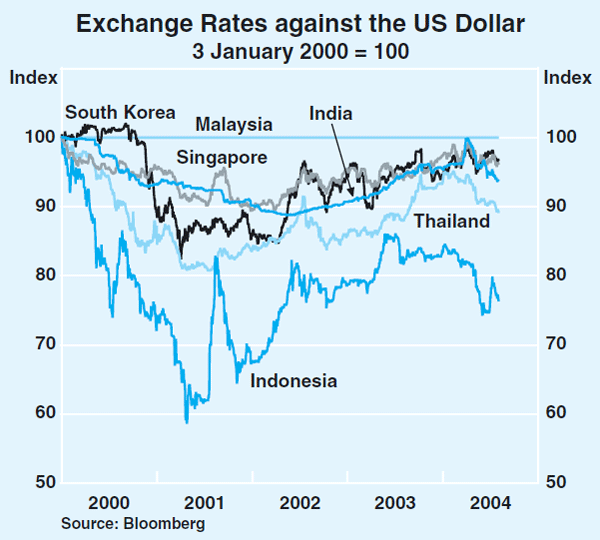
Australian dollar
After reaching a seven-year high of US80 cents in mid February 2004, the Australian dollar declined by 15 per cent (to just under US68 cents) against the US dollar by mid June and by 12 per cent (to 59) on a trade-weighted basis (TWI) (Graph 27). The depreciation was primarily a reflection of the strength of the US dollar over this period. It also reflected the reversal of some of the ‘yield plays’ that had been put in place over the previous year in which the Australian dollar had featured prominently. Consequently the Australian dollar's depreciation over this period tended to be larger than that of other currencies.
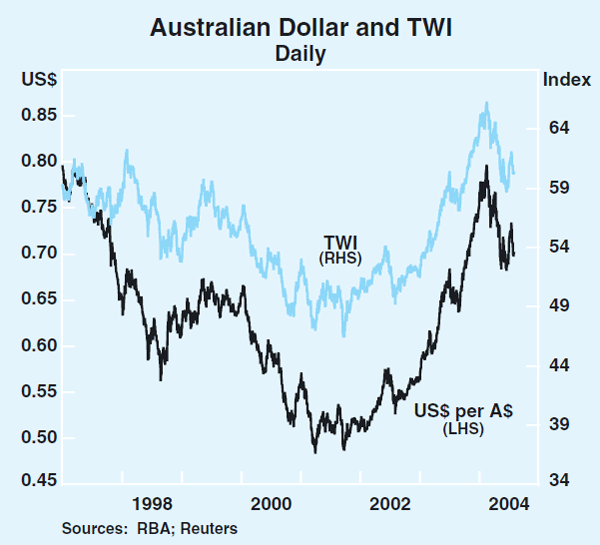
However, since mid June, the Australian dollar has risen modestly, reaching a high of 73½ US cents before easing back to around 70 cents more recently. While the most recent appreciation has again been largely a function of movements in the US dollar (see the section above on ‘Exchange rates’), the Australian dollar has also appreciated modestly against many of its other trading partners that float (Graph 28, Table 6) as some of the yield plays were reinstated. Continuing strength in commodity markets also boosted demand for the currency. Speculative positions on the Chicago Futures Exchange, which had been short for a few months earlier in 2004, have also turned back from short to long.

| Over past year |
Since 18 February 2004 peak |
Since mid June 2004 |
|
|---|---|---|---|
| Indonesian rupiah | 16.8 | −3.2 | 1.1 |
| Philippine peso | 9.8 | −12.2 | 2.1 |
| US dollar | 7.6 | −11.9 | 3.0 |
| Taiwan dollar | 6.9 | −9.0 | 4.3 |
| South Korean won | 6.3 | −11.0 | 3.5 |
| Singapore dollar | 5.4 | −9.3 | 3.3 |
| Swedish krona | 1.7 | −5.5 | 3.2 |
| European euro | 1.4 | −5.8 | 2.6 |
| Canadian dollar | 1.1 | −11.4 | −1.3 |
| Swiss franc | 1.0 | −7.9 | 4.9 |
| Japanese yen | −0.3 | −7.3 | 4.6 |
| New Zealand dollar | −2.6 | −3.3 | −0.4 |
| UK pound | −4.8 | −7.7 | 3.4 |
|
Source: RBA |
|||
The pattern described in the last Statement, whereby most of the significant moves in the Australian dollar occurred in the overnight trading sessions, has continued in the latest three months, indicating the continuing importance of offshore investors and events in influencing the exchange rate (Graph 29).
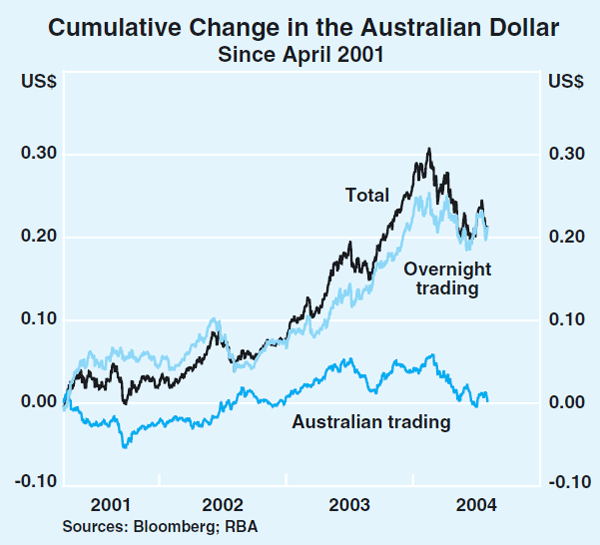
With the exchange rate no longer rising as strongly as it did through the second half of 2003 and early 2004, the Bank has stopped adding to its holdings of official reserve assets. Over the past three months purchases of foreign exchange have been limited to those necessary to cover the requirements of the government and therefore did not add to reserves. However, the A$ value of net foreign reserves has risen by almost $2 billion since the end of April, mainly due to valuation effects imparted by the lower Australian dollar. As at the end of July, net reserve assets were $24.5 billion.
The Bank has continued to make substantial use of foreign exchange swaps to manage domestic liquidity during the past three months. With the market facing large claims on liquidity due to seasonal tax collections, the Bank had $26.2 billion of swaps outstanding in late July.
Box B: Financial Tightening Measures in China
In 2003 and early 2004, economic growth in China accelerated to the point where the Chinese authorities were concerned that the economy was overheating. Consequently they adopted measures aimed at slowing growth to a more sustainable pace. Given the underdeveloped nature of the Chinese financial system, the policy approach adopted has differed from that used in most OECD economies, where short-term interest rates are the predominant financial macro-stabilisation tool. Efforts have focused largely on administrative and liquidity controls, which aim to slow investment through influencing the provision of credit.
In late 2003 the authorities undertook a number of measures aimed at reducing the liquidity in the economy, including increased issuance of central bank bills and increases in reserve ratios for banks. These have been supplemented more recently by a number of administrative measures. The authorities have sought to restrain bank lending in particular sectors of the economy including property, steel, cement, and aluminium, where they feel that the pace of growth is unsustainable.
- In February 2004, the China Banking Regulatory Commission (CBRC) required banks to limit their exposure to the property sector to a maximum of 30 per cent of outstanding loans.
- In April 2004, the State Council increased capital funding requirements by requiring larger cash deposits, and ordered that no new applications for steel, aluminium or cement projects be approved for the remainder of the year.
- In May 2004 the People's Bank of China (PBOC), CBRC, and State Development Reform Commission (SDRC) issued a joint statement directing banks to limit lending to industries that may be subject to over-investment. The CBRC has also directed banks to cease funding fixed-asset investment projects that have not obtained government approval.
- On a number of occasions over the past year, the PBOC has sought to influence the lending behaviour of commercial banks via ‘window guidance’ whereby it meets directly with banks to seek co-operation in achieving its policy goals.
To date interest rates have only had a limited role, with the key base lending rate (the one-year working capital rate) and the deposit rate unchanged since February 2002, at 5.31 per cent and 0.72 per cent respectively. There have, however, been minor adjustments to several other interest rates, with the PBOC increasing the ceiling on bank lending rates to 1.7 times the base lending rate (9.03 per cent) in January 2004, allowing banks to charge higher rates to borrowers. The previous ceiling had been 1.3 times the base lending rate for small enterprises, and 1.1 times the base lending rate for medium to large enterprises. In March the PBOC increased the interest rate ceiling on loans to commercial banks and for rediscounting trade bills.
Thus far, the measures look to have had some effect. Growth in bank lending has slowed from 24 per cent in the year to August 2003, to 16 per cent in the year to June 2004, while M2 growth has slowed from 22 per cent to 16 per cent over the same period (Graph B1).
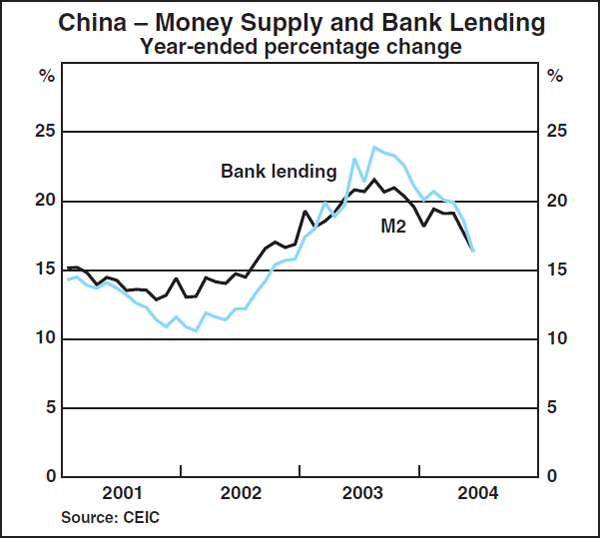
Domestic Economic Conditions
Following a rapid expansion over the second half of 2003, the Australian economy grew by a modest 0.2 per cent in the March quarter 2004, to be 3¼ per cent higher over the year (Graph 30). While GDP figures are not yet available for the June quarter, the early indications are consistent with a stronger result for the quarterly growth rate.
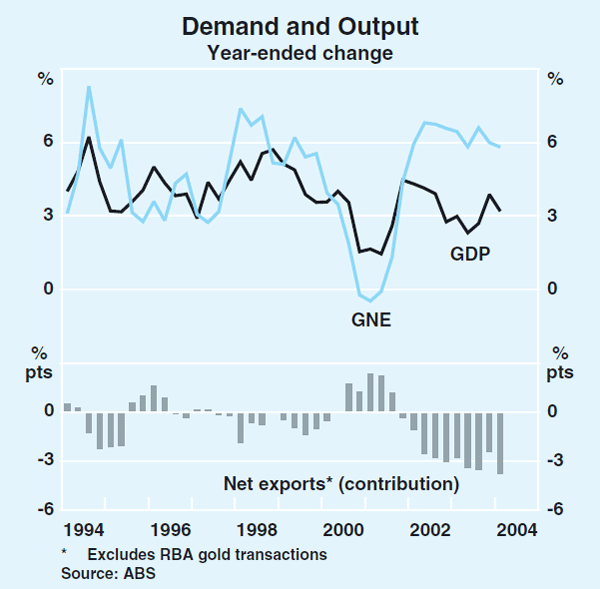
The slowing in growth in the March quarter national accounts reflected falls in all components of domestic final demand except household consumption. Consumer spending continued its recent strong growth, reflecting robust consumer confidence and the effects of previous increases in wealth. In contrast, both business investment and dwelling investment fell in the March quarter; the former is likely to be a temporary pause in growth, with survey indicators auguring well for business investment in the medium term, while the latter appears likely to be revised upwards based on more recent information. Offsetting these falls, a large build-up of stocks resulted in gross national expenditure increasing by 1¼ per cent in the quarter. Meanwhile, recovery in the rural sector continued, with farm output contributing 0.2 percentage points to quarterly GDP growth.
Despite reasonably solid export growth, net trade continued to weigh on growth in the March quarter. Import volumes grew at their fastest rate in nearly seven years, driven by the appreciation of the exchange rate over 2002–2003 and the ongoing strength in domestic spending. However, recent trade data suggest that growth in imports has since moderated, while export growth has remained solid, in line with the improving international environment. These developments, combined with an expected easing in growth in domestic spending, hold out the prospect for more balanced and sustainable growth in the period ahead.
Household sector
The rapid growth in consumer spending over the course of 2003 continued into the March quarter. Household consumption increased by 1.2 per cent, to be 6.2 per cent higher over the year. While growth in the quarter was broadly based, growth in expenditure on goods was particularly strong. Expenditure on motor vehicles rose strongly, underpinned by a high level of vehicle affordability, while expenditure on furnishings and household equipment also rose markedly, reflecting the strength in housing activity in the second half of 2003.
More recently, retail trade data for the June quarter show renewed strength, although not quite to the extent seen in the second half of 2003 (Graph 31). Much of the pick-up in spending occurred late in the quarter, with the value of retail sales rising by 2.1 per cent in June, buoyed by the lump-sum payments to families and carers announced in the 2004/05 federal Budget. These spending initiatives, along with income-tax reductions in the Budget, are likely to boost consumption in the next few quarters. Sales of motor vehicles fell slightly in the June quarter but remain at very high levels.

The ongoing strong growth in consumption is hardly surprising, given the favourable financial and labour market conditions of the past year and the strong gains in wealth since the late 1990s. In particular, the doubling of aggregate housing prices since 1998 has increased wealth significantly, helping to allow consumption growth to outpace the rise in income. While these wealth effects can be expected to diminish in line with the easing in housing prices since late 2003, the cumulative increase in wealth over the past decade remains considerable and may still have some way to work through. Consistent with the strong pace of growth in consumer income and spending, the Westpac-Melbourne Institute measure of consumer sentiment increased in July to the highest level in 10 years.
With household consumption growth running ahead of income growth, a further decline in the household saving ratio has occurred. At the same time, credit extended to households has continued to increase at a rapid pace over the first half of 2004, growing by around 19½ per cent over the year to June. With household debt continuing to rise, the aggregate household debt-servicing ratio increased further in the March quarter, to 9.4 per cent of disposable income (Graph 32). The increase also partly reflected the interest rate rises of late 2003, which flowed through to a higher average interest rate on household loans in the March quarter compared with the December quarter. Indicators of financial stress for the household sector, such as loan arrears, continue to suggest that the current debt-servicing burden is not significantly affecting household behaviour at present.
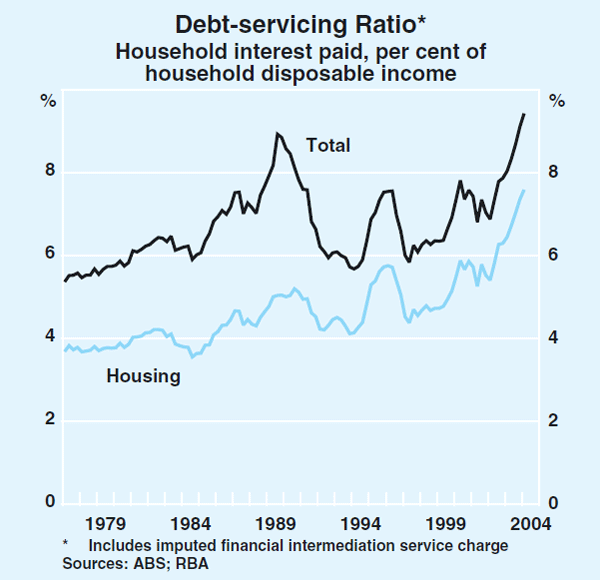
Housing
Activity
Following strong growth during the second half of 2003, the national accounts measure of dwelling investment fell by 1.3 per cent in the March quarter to be 3.1 per cent higher over the year. More recent ABS data on housing activity suggest that the national accounts measure of dwelling investment in the March quarter may be revised upwards to show a small rise.
The number of building approvals has been broadly flat in the first half of this year. While building approvals for detached houses have been on a downward trend since mid last year, since the end of last year there has been an offsetting increase in approvals in the medium-density sector, which have been sustained at high levels over the past three months (Graph 33). The value of building approvals for renovations and extensions has also picked up over the past three months, after a period of weakness earlier in the year. Other leading indicators of housing construction have been more suggestive of a slowing in housing activity. Display home traffic and land sales are well below levels of a year ago, and the Housing Industry Association series of commitments to build houses remains below its recent peak (Graph 34). In addition, a survey by the Master Builders Association of its members, conducted in May and June, reported that housing construction activity fell in the June quarter. Nonetheless, along with the generally favourable macroeconomic outlook and continuing strength in underlying demand for housing, the data for approvals and work in the pipeline suggest that the expected cyclical downturn in dwelling investment is likely to be very modest by historical standards.
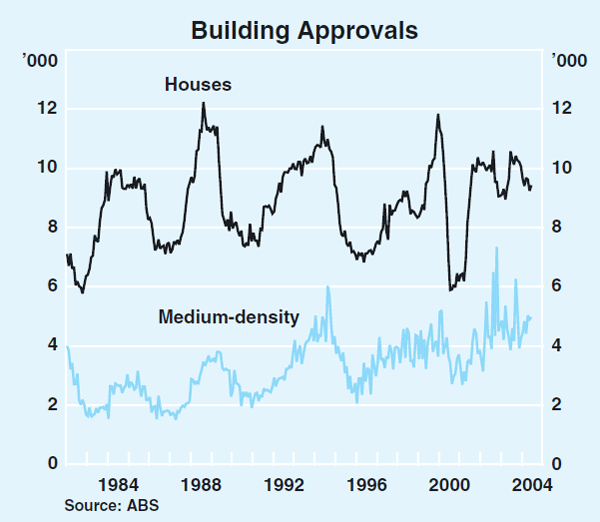
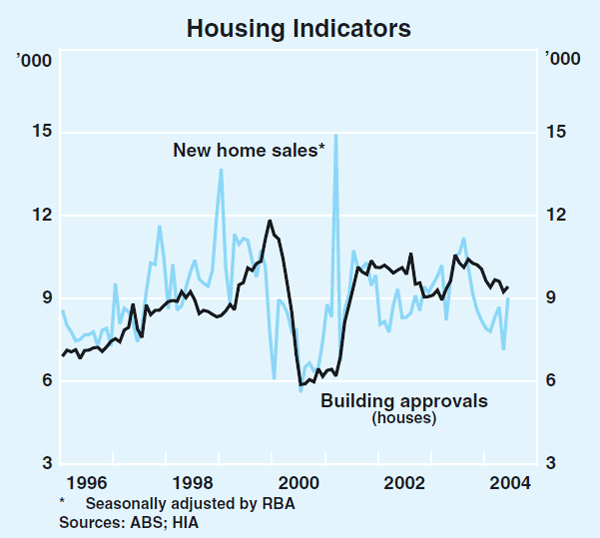
Financing and prices
After peaking at $15 billion in October 2003, the value of monthly housing loan approvals stabilised over the first five months of 2004 at an average level of around $12½ billion (Graph 35). Although loan approvals to investors have come off by more than approvals to owner-occupiers, investor approvals are still far above the levels of a few years ago. These developments in loan approvals have been reflected in broadly consistent behaviour of housing credit. Housing credit continues to grow strongly, rising at an annualised rate of 18½ per cent over the six months to June, compared with its peak annualised growth rate of 22½ per cent over the second half of 2003. Looking ahead, the value of housing loan approvals would need to fall significantly further to bring housing credit growth back to a more sustainable pace.
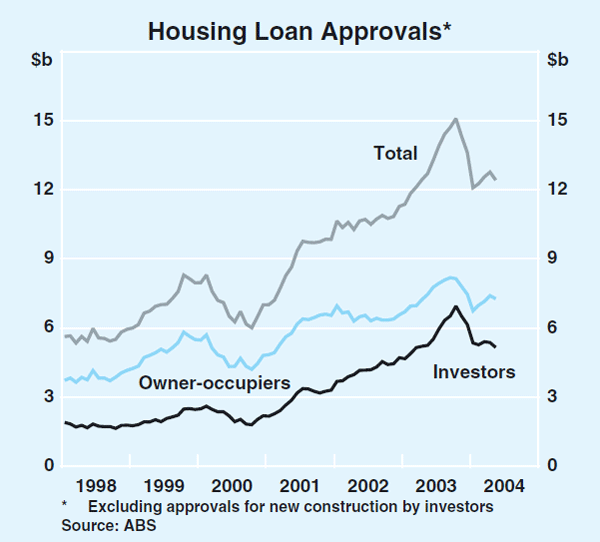
A reasonable amount of data is now available for house prices in the June quarter: the Commonwealth Bank (CBA) figures, preliminary estimates from Australian Property Monitors (APM), the reports from four of the state Real Estate Institutes (REIs) and some preliminary figures for three state capitals from Residex (Table 7). Like the March quarter, the predominant result is for price falls, particularly for Sydney and Melbourne. Details of the different methodologies of each price measure are explained in the article ‘Measuring Housing Prices’ in the July Bulletin.
| CBA | APM | REIs | Residex | |
|---|---|---|---|---|
| Sydney | −6.5 | −8.5 | na | −0.5 |
| Melbourne | −3.2 | −2.1 | −2.8 | 1.1 |
| Brisbane | 1.3 | 0.6 | −2.5 | 2.6 |
| Adelaide | −1.8 | 2.8 | 3.2 | na |
| Perth | 2.7 | −2.0 | −1.0 | na |
| Canberra | 12.2 | −2.2 | na | na |
| Australia | −3.4 | −4.4 | na | na |
|
Sources: CBA; APM; state REIs; Residex |
||||
The CBA figures show price falls in Sydney and Melbourne, a smaller fall in Adelaide, and rises elsewhere. These figures are for house purchases made by the CBA's customers and are not subject to revision. The APM figures show falls for Sydney, Melbourne, Perth and Canberra. These are preliminary figures and, on the basis of previous experience, are likely to be revised upwards as the sample size increases when additional transactions are included in the state government data.[1] The state REIs show price falls in Melbourne, Brisbane and Perth, and a rise in Adelaide. As in the March quarter, the Residex figures show a flatter picture than the other measures.
There are now enough data to compare developments in the two halves of 2003/04 (Table 8). This approach has the advantage of eliminating some of the quarter-to-quarter variability in the various series. It is clear that in each measure there has been a major turnaround between the two half-years. Each measure shows strong increases over the second half of 2003 in all cities, with the only exception being that two series show only moderate increases for Melbourne at that time. For the first half of 2004, the general tendency is for prices to fall, including on average for Australia, but the picture is more mixed. Three of the series show falls for Sydney and Melbourne, and two of the four show falls for Brisbane. For the other capitals, most measures show a flat picture or modest increases. Interestingly, the averages for Australia from the CBA and APM for the two half-years are remarkably similar (subject to the caveat that the APM figures will be revised).
| CBA | APM | REIs | Residex | ||||||||
|---|---|---|---|---|---|---|---|---|---|---|---|
| 2003II | 2004I | 2003II | 2004I | 2003II | 2004I | 2003II | 2004I | ||||
| Sydney | 12.0 | −9.2 | 16.3 | −7.0 | 7.5 | na | 9.3 | −0.6 | |||
| Melbourne | 13.6 | −8.0 | 12.5 | −9.8 | 3.3 | −3.5 | 3.5 | 1.3 | |||
| Brisbane | 21.0 | −0.8 | 22.8 | 1.3 | 21.1 | −1.4 | 22.1 | 2.5 | |||
| Adelaide | 13.5 | −3.5 | 9.1 | 6.3 | 9.1 | 6.3 | na | na | |||
| Perth | 11.9 | 2.2 | 8.7 | 0.0 | 12.4 | 1.7 | na | na | |||
| Canberra | 30.6 | 0.2 | 10.5 | −0.7 | 9.0 | na | na | na | |||
| Australia | 14.0 | −6.5 | 14.7 | −5.1 | 8.5 | na | na | na | |||
|
Sources: CBA; APM; REIA and state REIs; Residex |
|||||||||||
The evidence regarding apartment prices also suggests that nationwide prices have fallen over the first half of 2004, following the strong increases seen in 2003 (Table 9). The CBA series suggest a small fall in nationwide average prices, driven by falls in Sydney and Melbourne. The estimates from APM suggest a larger fall, but are subject to revision. Both series, however, show smaller falls for apartment prices than for house prices. This result is not consistent with many industry reports, which suggest greater weakness in the apartment sector than for houses.
| CBA | APM | REIs | Residex | ||||||||
|---|---|---|---|---|---|---|---|---|---|---|---|
| 2003II | 2004I | 2003II | 2004I | 2003II | 2004I | 2003II | 2004I | ||||
| Sydney | 17.0 | −2.6 | 5.0 | −2.1 | 1.5 | na | 5.1 | −1.3 | |||
| Melbourne | −4.5 | −0.8 | 5.3 | −8.8 | 3.6 | −1.4 | 2.0 | 0.8 | |||
| Brisbane | 1.2 | 8.9 | 13.7 | 3.6 | 12.1 | na | 23.5 | 4.9 | |||
| Adelaide | 20.1 | 1.5 | 8.8 | 7.2 | 9.1 | na | na | na | |||
| Perth | 23.3 | 1.3 | 1.9 | 6.9 | 11.5 | na | na | na | |||
| Canberra | na | na | 14.0 | 0.0 | 9.0 | na | na | na | |||
| Australia | 9.2 | −0.2 | 6.2 | −2.1 | 4.7 | na | na | na | |||
|
Sources: CBA; APM; REIA and state REIs; Residex |
|||||||||||
Although they represent only a small proportion of total sales, auction results also suggest that demand remains subdued in the housing market. Despite picking up a little in recent weeks, auction clearance rates in Sydney and Melbourne remain well below the levels observed in the equivalent periods in previous years (Graph 36).
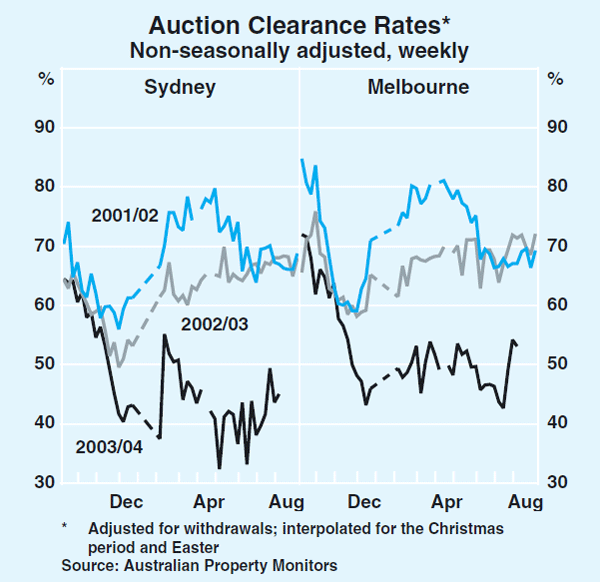
Business sector
Conditions in the business sector have remained strong. Business expectations and investment intentions are positive, profitability is at a high level, and the strengthening outlook for the world economy is contributing to improved prospects for the trade-exposed sectors.
Production in the non-farm economy expanded at a modest pace in the March quarter, while farm output remained strong as the rural recovery consolidated, despite continued dry conditions in some regions. After a protracted period of divergent outcomes, the goods and services sectors saw similar year-ended growth rates of output. In the non-farm economy, output growth remained strongest in those industries exposed to domestic demand, including wholesale and retail trade, construction, transport, and business services. In contrast, growth was much weaker in export-oriented industries, particularly in mining, where expansion of output has been inhibited by capacity constraints and temporary disruptions to production (Graph 37).
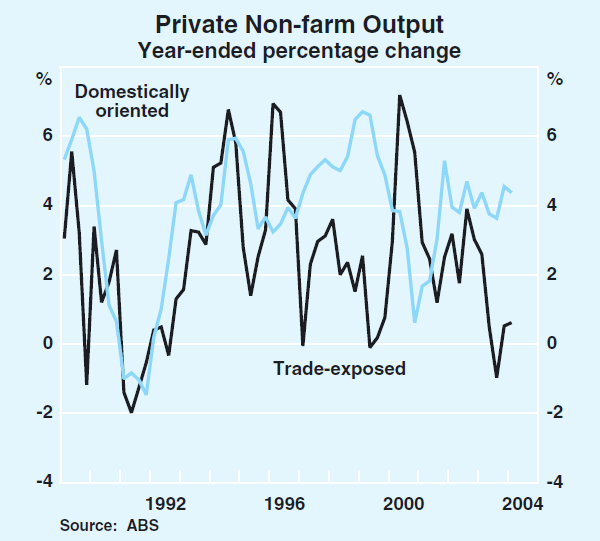
Surveys show that business conditions remained healthy in the June quarter. The NAB survey of the non-farm sector reported that business conditions were well above long-run average levels, underpinned by high levels of sales, profitability and employment (Graph 38). Orders were strong and capacity utilisation was around the level of previous peaks, although it was down from the level in the December quarter 2003. In contrast to the national accounts data for 2003 and the March quarter 2004, the survey suggests that business conditions strengthened in the export-oriented industries of mining and manufacturing in response to the recovery in economic activity abroad. In contrast, conditions eased in construction and some of the other industries sensitive to domestic demand.
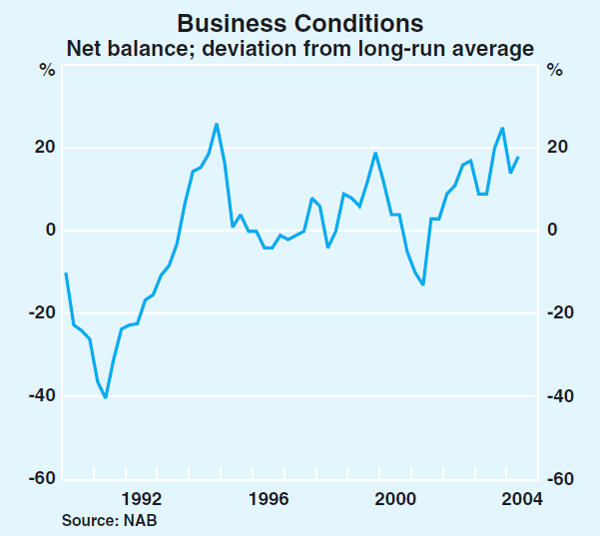
The Australian Industry Group (AIG) and ACCI-Westpac surveys pointed to similarly strong business conditions in the manufacturing sector. Like the NAB survey, the AIG survey suggests some rebalancing of activity towards export-oriented industries. The ACCI-Westpac survey's composite index of activity, comprising survey measures of employment, new orders, output and overtime, rose in the June quarter to be well above its long-run average level.
Corporate profits weakened in the March quarter, but remained 6½ per cent higher over the year following the strong growth seen in the second half of 2003. Profitability in domestically focused industries has been strong for some time, while mining profitability was affected by the appreciation of the exchange rate up to the March quarter. The profitability of unincorporated enterprises remained firm in the quarter, driven by the continued recovery in farm profitability. Looking forward, business surveys show profitability is expected to remain higher than average.
The high level of corporate profitability continues to provide firms with a solid base of internal funds to pursue their investment plans. In addition, corporate gearing and debt-servicing costs remain low. External fund raising activity was subdued in the March quarter, but rebounded in the June quarter. Over the year to June, growth in business credit remained around the average recorded over recent years.
Following robust growth in the second half of 2003, new business investment contracted by 1.5 per cent in the March quarter 2004 (Graph 39). The fall was driven by a 2.3 per cent decline in the machinery and equipment component, though this movement is a little at odds with the strong rise in capital equipment imported in the quarter. Buildings and structures investment held at the high level reached at the end of 2003, with growth in engineering construction more than offsetting a fall in the non-residential building component. However, more recent ABS data suggest that both of these components are likely to be revised down.
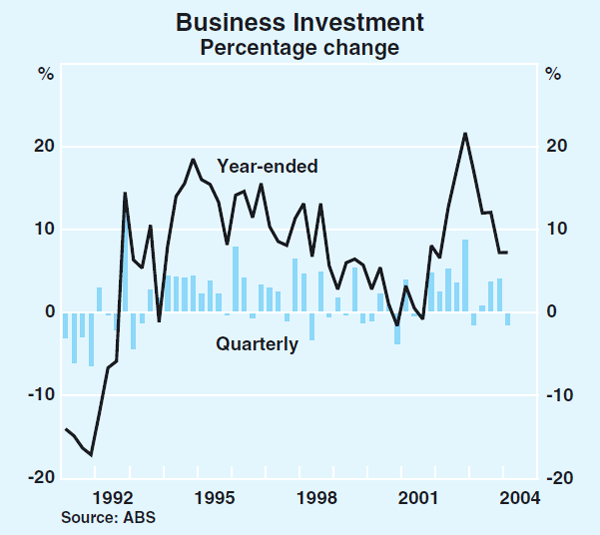
Despite the weak March quarter investment outturn, the high level of capacity utilisation and healthy financial position of businesses remain supportive of further growth in business investment. The current upswing in world growth, together with the easing in the exchange rate from its early 2004 peak, is likely to provide additional impetus to investment by firms exposed to the external sector.
Recent surveys of investment intentions confirm that the medium-term outlook for investment is positive and has improved in the past three months. The latest ABS Capital Expenditure (Capex) survey points to solid growth in business investment in 2004/05. Intentions for machinery and equipment investment, adjusted by a five-year average realisation ratio, suggest year-average growth of around 5 per cent in real terms. Similarly, the Rabobank survey reports that equipment investment in the farm sector – which is not included in the Capex survey – is likely to remain strong over the year ahead at close to pre-drought levels.
The Capex survey indicates that intentions for buildings and structures investment have been revised up significantly in recent months, particularly in the mining sector, and now suggest a substantial lift in growth in 2004/05. Other forward-looking indicators of investment in buildings and structures also suggest continued strength in the overall non-residential construction cycle. Indications are that growth will be heavily skewed towards the engineering construction component of activity. Consistent with the strong world demand for resources, the Access Economics Investment Monitor notes the recent commitment to the construction of a number of high-value projects designed to expand capacity in the resources sector in late 2004. In contrast, the recent decline in the value of building work approved suggests that the non-residential building cycle is likely to have peaked, though the high level of work yet to be done is likely to support activity at high levels in the near term (Graph 40).
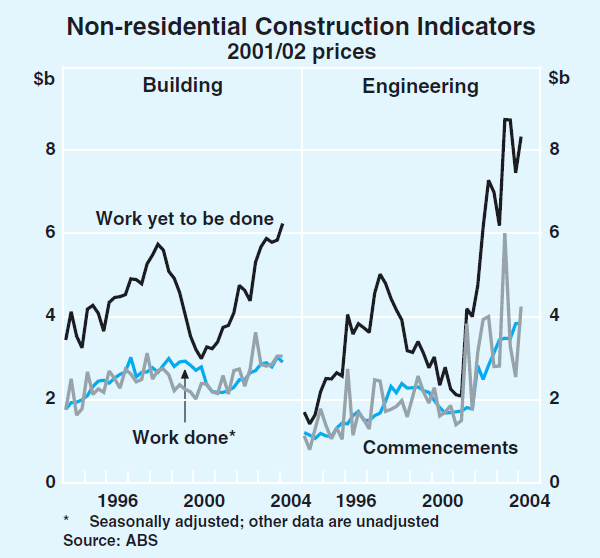
Australian Government Budget
The 2004/05 Australian Government Budget, delivered in May, showed a modest reduction in the expected surplus in both underlying cash and accrual terms (Graph 41). This reflected a number of new policy decisions, which more than offset the higher forecast for revenue collections in the budget year. New policy decisions announced in the Budget included personal income tax cuts, additional payments to families eligible for the Family Tax Benefit, and increased spending directed at aged care and retirement savings. Fiscal policy is therefore likely to be expansionary in 2004/05. In addition, the budgets of state governments are expected to have a further mild expansionary impact.
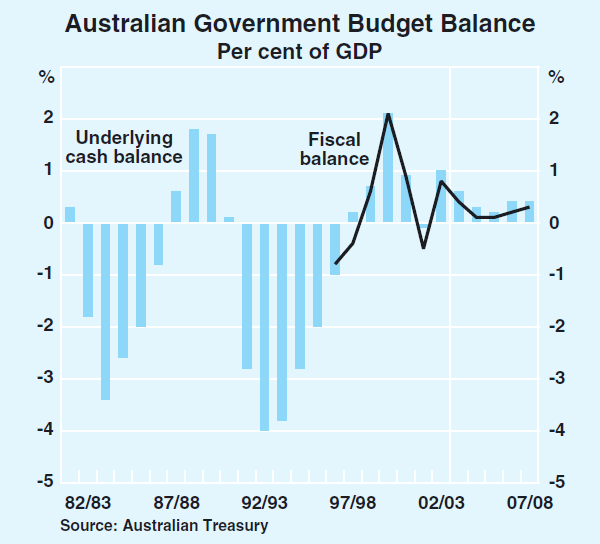
Labour market
Labour market conditions remained firm over the first half of 2004. Employment grew by 0.8 per cent in the June quarter, and by 2.3 per cent over the year. After several years in which growth had been driven by part-time employment, employment growth has more recently been heavily concentrated in full-time jobs (Graph 42).
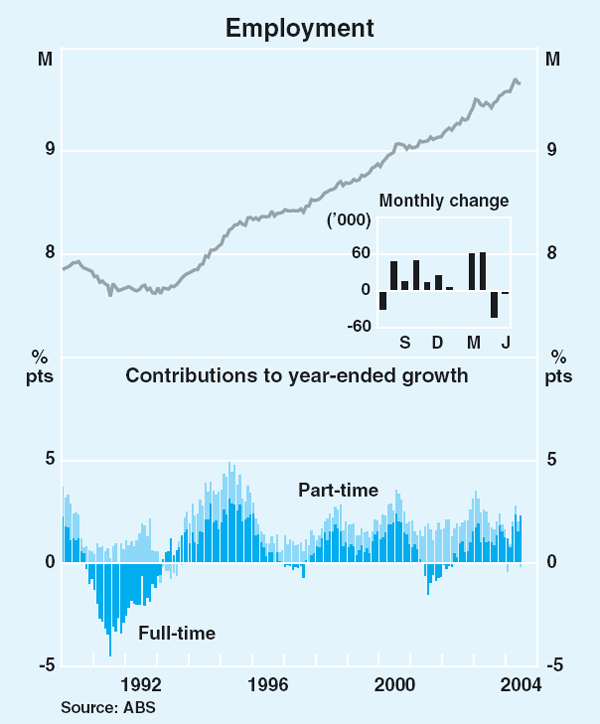
The unemployment rate continued to decline in the first half of 2004, driven by the strong gains in employment more than by the small fall in the number of people looking for work. In recent months the unemployment rate has been around 5½ per cent, which is roughly equal to the low points reached in 1981 and 1989 (Graph 43). The participation rate stood at 63½ per cent in June and, looking through the monthly volatility, it has been around this level for most of the past year.
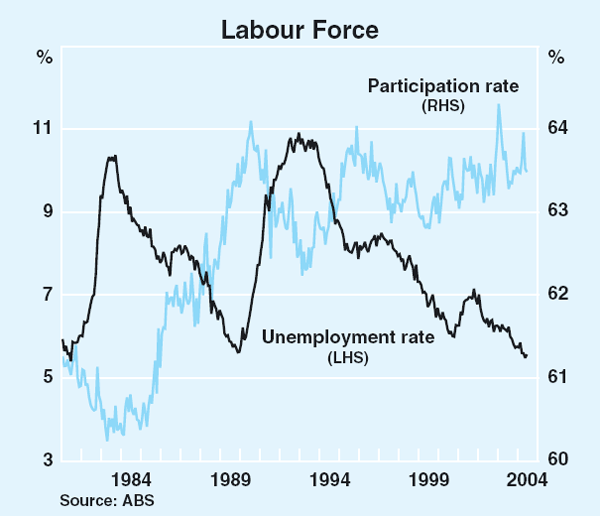
Employment increased and the unemployment rate fell in all states over the year to the June quarter, though the improvement was only marginal in South Australia, where growth in final demand has been relatively soft (Table 10). The strongest growth in employment and state final demand over the past year, and the largest falls in the unemployment rate, occurred in Queensland, Tasmania and Western Australia.
| Employment growth | Unemployment rate | ||||
|---|---|---|---|---|---|
| Quarterly | Year-ended | 2004 | 2003 | ||
| NSW | 0.2 | 1.7 | 5.5 | 6.0 | |
| Victoria | 0.7 | 2.2 | 5.6 | 6.0 | |
| Queensland | 1.4 | 4.2 | 5.8 | 6.9 | |
| WA | 1.6 | 2.7 | 5.1 | 5.9 | |
| SA | 0.4 | 0.1 | 6.2 | 6.3 | |
| Tasmania | 0.3 | 3.7 | 6.8 | 8.3 | |
| Australia | 0.8 | 2.3 | 5.6 | 6.2 | |
|
Source: ABS |
|||||
At the industry level, employment growth in education, health and community services accounted for most of the overall gains over the year to the June quarter (Table 11). Within these industries, growth was concentrated in the professional occupations. The other main source of employment growth over the past year was the construction industry. In manufacturing, employment has recovered after a period of job shedding in trade-exposed sectors, and solid gains in recent quarters have seen overall manufacturing employment return to around the level of a year earlier. The main industry to subtract from employment over the past year was retail trade, where employment growth had previously been very strong.
| Share of total 2003 | Growth Per cent | Contribution to growth Percentage points |
|
|---|---|---|---|
| Agriculture | 3.9 | −4.1 | −0.2 |
| Construction | 8.0 | 10.5 | 0.8 |
| Education | 7.2 | 8.4 | 0.6 |
| Govt administration & defence | 4.7 | 5.1 | 0.2 |
| Health & community services | 9.8 | 5.6 | 0.6 |
| Manufacturing | 11.4 | 0.1 | 0.0 |
| Property & business services | 11.8 | −0.3 | 0.0 |
| Retail trade | 15.3 | −3.0 | −0.5 |
| Other | 27.8 | 1.6 | 0.5 |
| All industries | 100.0 | 2.0 | – |
|
(a) Data relate to mid month of the quarter Source: ABS |
|||
Forward-looking indicators of labour demand presage further solid employment growth in the near term (Graph 44). The ABS measure of job vacancies picked up sharply in the June quarter and similarly strong signals have come from various internet-based vacancy series. Print-based indicators have also risen in recent months, though more modestly, and recent business surveys suggest that hiring intentions remain above long-run average levels. A wide range of business surveys, including the NAB survey, ACCI-Westpac survey, the Sensis Business Index of small and medium businesses, and the ACCI Survey of Investor Confidence, have pointed to firms experiencing difficulty finding suitably qualified labour (Graph 45).
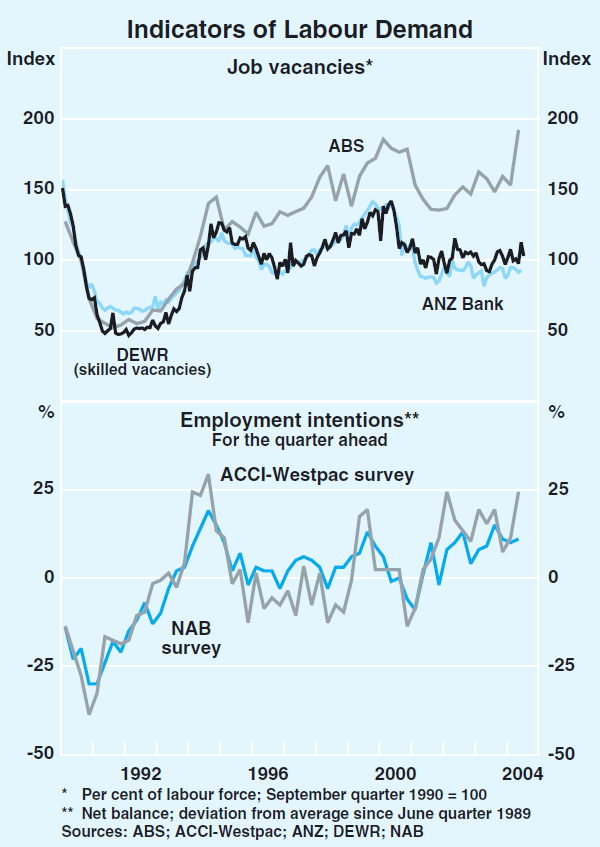
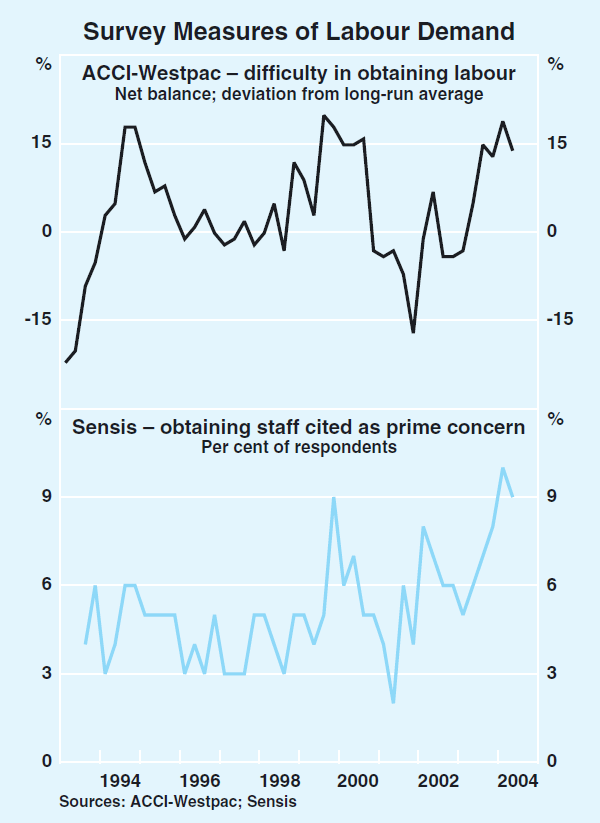
Balance of Payments
Developments in the terms of trade have been a major factor influencing the balance of payments over the past year. The terms of trade have increased by more than 10 per cent over this period, driven largely by rising world commodity prices. This has contributed to a narrowing in the deficit on trade in goods and services from the peak of 3½ per cent of GDP in mid 2003, to around 3 per cent of GDP in the June quarter 2004 (Graph 46). In line with the narrowing in the trade deficit, the current account deficit is also likely to have narrowed in the June quarter to around 5¾ per cent of GDP from around 6½ per cent a year earlier (assuming that the net income deficit has remained constant as a share of GDP). These declines have, however, been smaller than might have been expected given the easing in drought conditions and the pick-up in global demand and world commodity prices since mid last year. This has reflected both a relatively modest recovery in export volumes to date, and continued strong growth in import volumes.
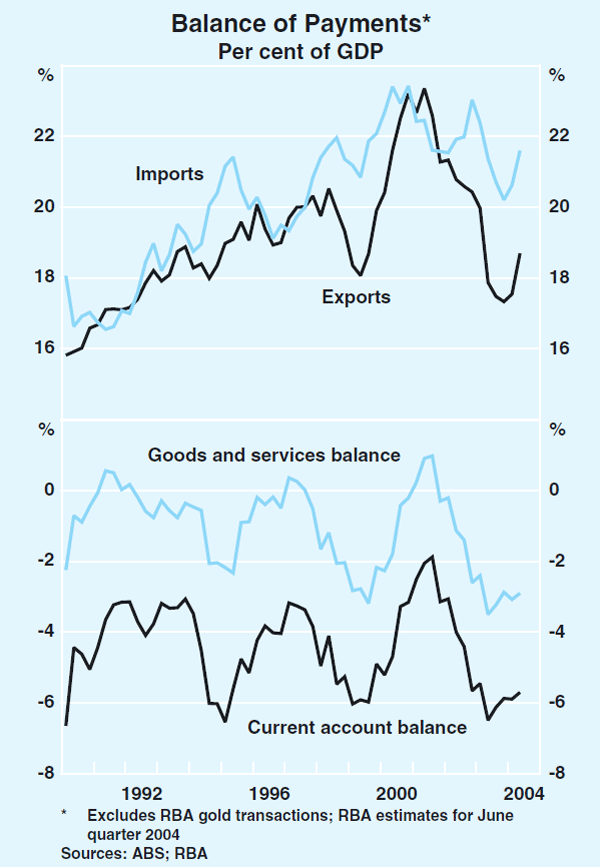
Exports
Export earnings have risen by about 12½ per cent since mid 2003, with much of the increase coming in the June quarter, when the value of exports rose by around 8½ per cent (Graph 47). Part of the increase over the past year has been due to rising prices, with export volumes up by around 8½ per cent since mid 2003. While it now seems clear that export volumes have passed their trough, the recent growth follows quite a lengthy period of subdued performance when exports had been dampened by the global economic downturn as well as by adverse conditions affecting tourism and rural exports. Seen against this background, the pick-up in export volumes so far has been relatively modest.
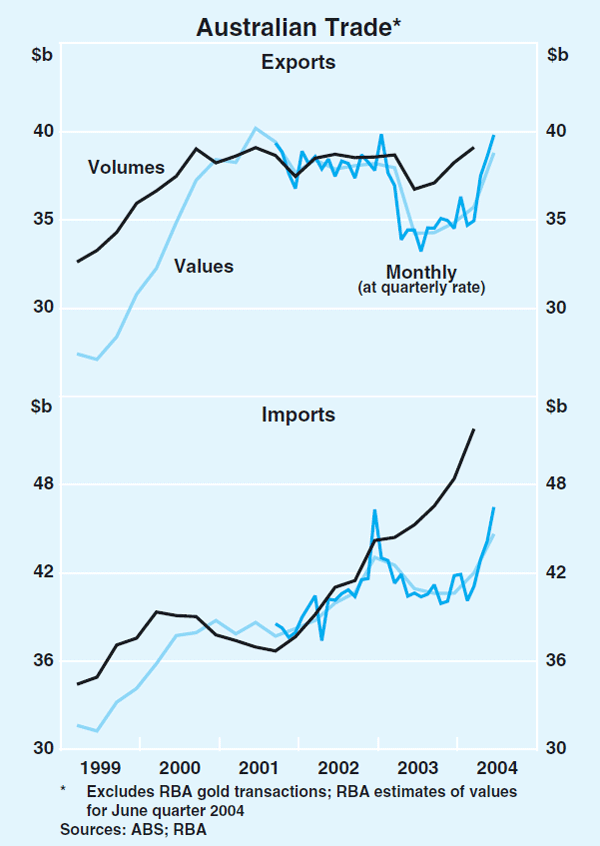
Resource export earnings have been boosted by rising prices over the past year but, to date, the sector has been characterised by disappointing performance in terms of volumes (Graph 48). The large rise in the value of resource exports of around 14 per cent in the June quarter was mainly due to significantly higher contract prices for bulk commodities, but was also boosted by the decline in the exchange rate between March and June. However, the volume of resource exports is estimated to have remained largely unchanged in the June quarter, continuing the broadly flat trend evident since 2000.

As resource export volumes are driven predominantly by supply factors, this subdued growth performance appears mainly to reflect the limited expansion in production capacity in recent years. This in turn has been a consequence of the sharp downturn in resource-related investment between 1998 and 2000, when commodity prices were at their lowest level in a decade (Graph 49). However, there are good prospects that these capacity constraints will ease over time. Resource-related investment has surged over the past three years, in line with strengthening global demand and commodity prices. Given the long lead times for resource projects, these investments have mostly not yet come on stream but are expected to result in significant capacity expansions later this year and next, particularly in coal, metal ores and LNG production. For example, data from Access Economics indicate that the value of resource projects completed in 2004 is likely to be around five times the level of completions in 2003.
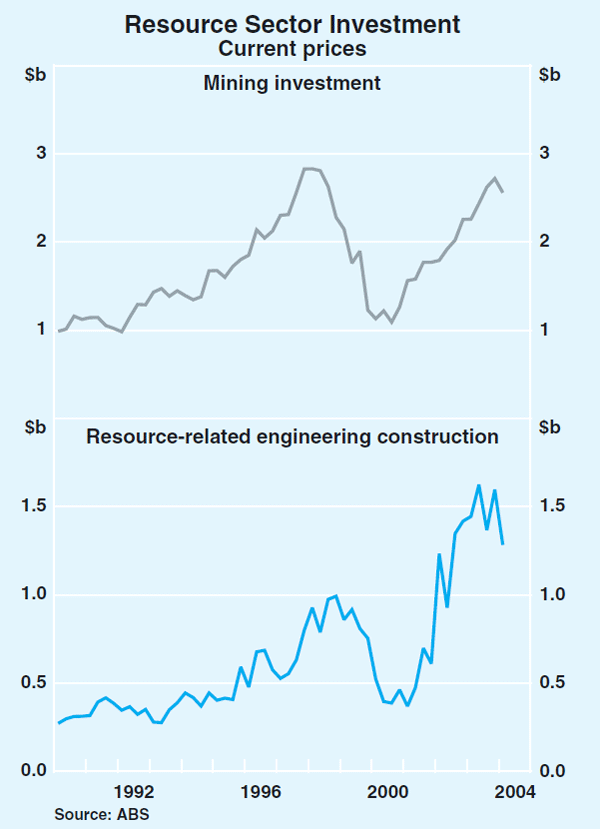
Another key development in resource exports has been the steep decline in exports of ‘other mineral fuels’ – comprising oil, gas and other petroleum products – which have fallen by over 20 per cent since late 2000. This largely reflects declining oil production as some of Australia's oil fields are reaching the end of their productive lives, a trend which is expected to continue in the near term. Recent investment in this sector, however, points to an impending expansion in production, particularly, as noted above, for LNG. In addition, since mid 2003, resource exports have been hampered by transport infrastructure constraints, and more recently, an unusual spate of temporary supply disruptions. These infrastructure constraints are expected to be addressed over the next year or two, with expansion of several major ports and connecting rail facilities underway or soon to commence.
The value of manufactured exports began to recover in the first half of 2004, rising by around 7 per cent in the June quarter, following a similarly strong increase in the previous quarter, and largely reversing the decline seen over 2003. While volumes have also picked up during 2004, overall export performance in the sector has lagged the recent acceleration in growth among our trading partners. Part of this weakness is likely to have been related to a loss of competitiveness in world markets flowing from the appreciation of the exchange rate over the past couple of years. Another factor is the strength of domestic demand, which has made it easier for manufacturers to sell their products in the home market.
The value of rural exports has increased strongly over recent quarters from the drought-induced trough of mid 2003. Rural export earnings rose by a further 16 per cent in the June quarter, to be 36 per cent higher over the year. This recovery has been driven by a sharp increase in volumes. Cereals exports have accounted for most of this rise, following the record 2003/04 winter crop, along with increases in all other major components in the June quarter. However, the near-term outlook for rural exports will continue to be affected by the lingering effects of the drought, with the recovery in livestock-based exports likely to be protracted. In addition, a dry autumn delayed winter-crop plantings in many areas, though recent rains generally allowed planting to proceed, and the Bureau of Meteorology considers that the risk of an El Niño event later this year has subsided. Overall, the Australian Bureau of Agricultural and Resource Economics expects little change in livestock-based production in 2004/05 and only a 1½ per cent increase in crop production, given the rebound that has already occurred.
The value of service exports dipped slightly in the first half of 2004. The combination of the general recovery in international tourism from the SARS outbreak, a pick-up in world economic growth and the boost provided by the Rugby World Cup resulted in exceptionally strong growth in the second half of 2003. Since then, the number of overseas arrivals has levelled off, leaving the value of service exports around 4 per cent above the average in 2002 (Graph 50).
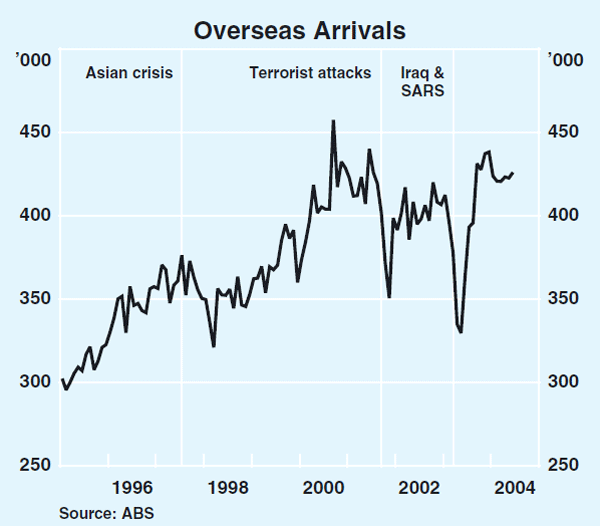
Imports
In contrast to the relatively modest growth of exports, import volumes have continued to grow strongly over recent quarters. This has been driven by robust growth in domestic demand and the falls in import prices that resulted from the appreciation of the Australian dollar over 2002–2003 (refer Graph 47). The volume of imports rose by 7 per cent in the March quarter 2004, to be around 17 per cent higher over the year. Growth in imports has been broad-based in consumption, capital and intermediate goods. Service imports have also expanded at a firm pace, with international travel by Australians buoyed by the rise in the Australian dollar since 2002. Import values rose by a further 6¼ per cent in the June quarter, with this outcome probably reflecting solid growth in volumes and higher prices following the depreciation of the exchange rate between March and June.
Commodity prices and the terms of trade
Rising global demand continues to support world commodity prices, despite some easing in prices in recent months. The RBA Index of Commodity Prices fell by 0.3 per cent over the three months to July, though it remains around 16 per cent above its trough in May 2003. The decline over recent months has been driven by weaker prices for rural commodities, though these have been partly offset by stronger prices for bulk commodities, with base metals prices also moving higher (Graph 51, Table 12). In contrast, with the Australian dollar having eased since February, commodity prices in Australian dollar terms have increased solidly, rising by 4.6 per cent over the past three months to approach the elevated levels seen during 2001–2002.
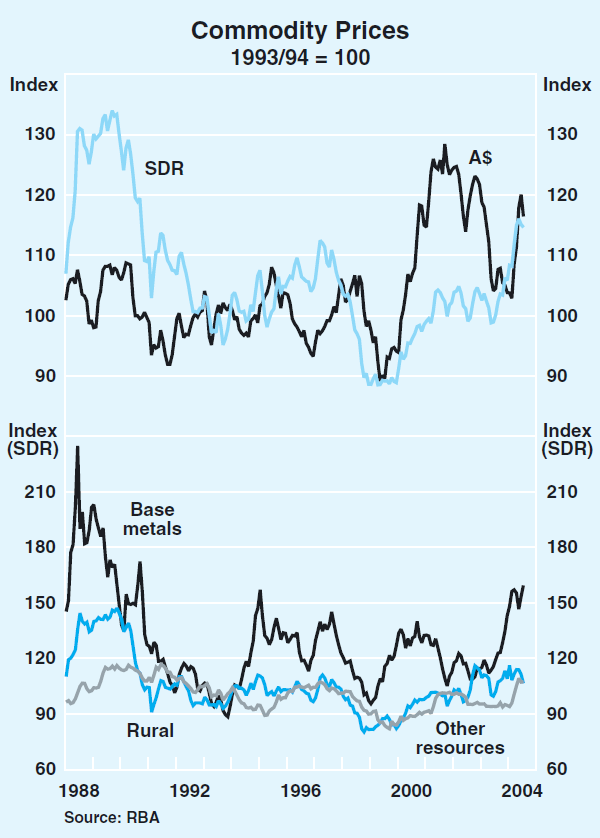
| Three months to July | Year to July 2004 | |
|---|---|---|
| RBA Index | −0.3 | 14.5 |
| Rural | −6.5 | 4.4 |
| – Wheat | −12.9 | 4.7 |
| – Beef and veal | −2.2 | 14.4 |
| – Wool | −1.5 | −8.2 |
| Base metals | 2.6 | 33.5 |
| – Aluminium | −2.1 | 12.6 |
| – Copper | −4.6 | 56.2 |
| – Nickel | 16.3 | 61.5 |
| Other resources | 2.2 | 14.4 |
| – Coking coal(a) | 7.8 | 15.8 |
| – Steaming coal(a) | 13.7 | 45.3 |
| – Gold | −2.3 | 7.6 |
| Memo item: | ||
| Oil in US$(b) | 10.8 | 32.5 |
|
(a) Latest available data are for June. Sources: Bloomberg; RBA |
||
Expanding global industrial production, particularly in China, and an associated decline in stocks of raw materials have remained supportive of base metals prices. Over the three months to July, base metals prices rose by 2.6 per cent in SDR terms, driven by sharp increases in the prices of nickel and lead. This recent strength in base metals prices reversed the weakness seen in late April this year amid market speculation that measures taken by the Chinese authorities to slow the pace of growth in China may prove too heavy-handed. On average, base metals prices are more than 40 per cent above the level of late 2002.
The prices of other resource commodities have increased substantially in recent months following significant rises in negotiated contract prices for the year ahead. Coking coal contract prices were settled, on average, around 25–35 per cent higher than last year in US dollar terms, underpinned by strengthening global steel demand. There has been further upward pressure on prices since many contracts were settled, with continued strong demand and growing signs of shortages in some countries. Steaming coal contracts for 2004/05, which were generally settled later than for coking coal, locked in price rises of up to 70 per cent, reflecting growing energy demand coupled with supply shortages owing to disruptions in major exporting countries.
Rural commodity prices have eased recently, falling by 6.5 per cent over the three months to July. Wheat prices have declined significantly over recent months, reflecting increased supply from the current US harvest, as well as expectations of increased global wheat production in the coming year. A forecast rise in global cotton production has also weighed on cotton prices.
The ongoing strength in world prices for Australia's exports, particularly for many commodities and services, combined with more subdued growth in import prices, continues to underpin a marked upward trend in Australia's terms of trade. After increasing by nearly 4 per cent in the March quarter, the terms of trade were 10 per cent higher than a year earlier, reaching their highest level in almost 28 years (Graph 52). The terms of trade appear likely to have increased further in the June quarter, given the considerable strength in bulk commodity prices observed in recent months.
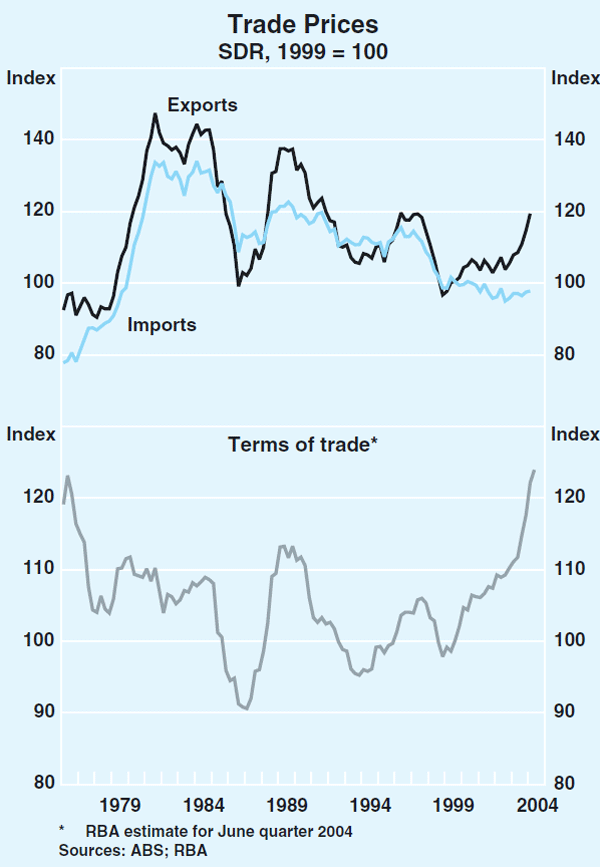
Domestic Financial Markets
Interest rates and equity prices
Money and bond yields
Short-term market yields have not changed much in the past three months. They remain a little above the current cash rate (Graph 53). Markets are not expecting any change in the cash rate in the near future, though some rise is expected in due course.
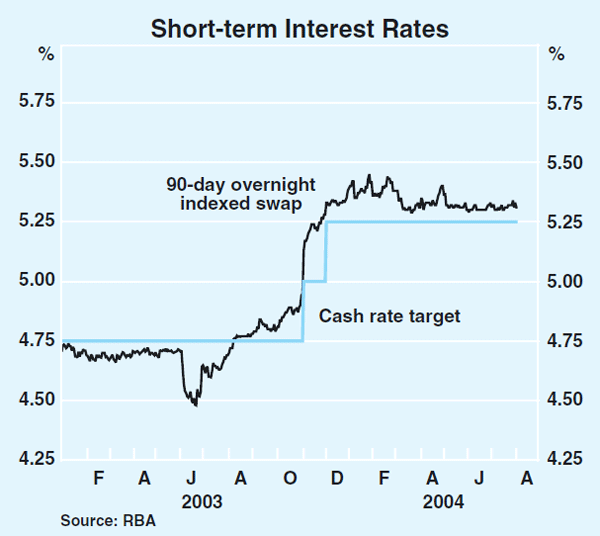
Yields on 10-year government bonds, which had been around 6 per cent in the first half of May, have since fallen to around 5.7 per cent. Yields on 10-year inflation-linked bonds have moved similarly to be around 3.2 per cent in early August (Graph 54).
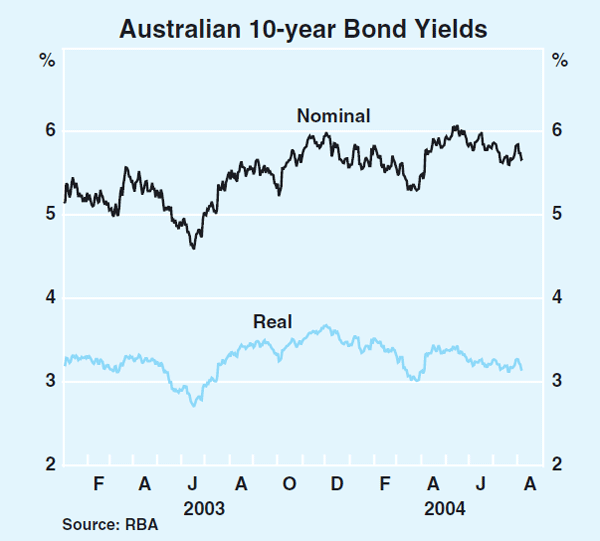
The yield curve has flattened somewhat over the past three months reflecting the falls in longer-term yields. The spread between yields on 10-year bonds and the cash rate was around 45 basis points in early August compared with around 70 basis points in early May (Graph 55). This is well below its average for the past decade.
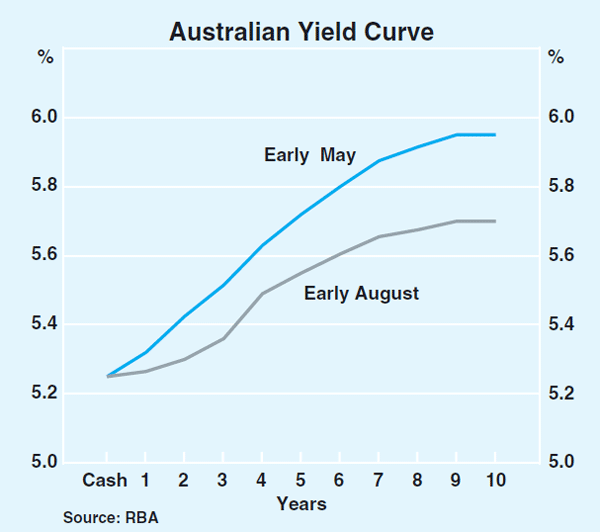
The fall in domestic bond yields over recent months has been a little more than in the US, so the spread between the US and Australian 10-year government bond yield has narrowed from 135 basis points in early May to around 125 basis points (Graph 56).
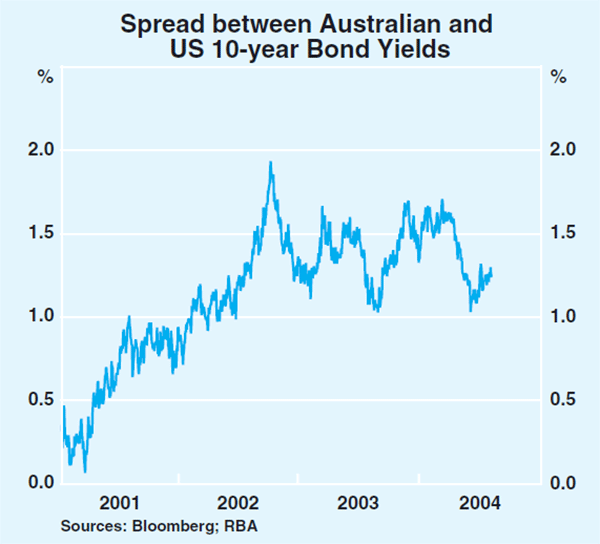
There has been little change in the market's perceptions of credit risk during the past three months. Spreads between corporate bond yields and swap rates and the premia on credit default swaps (CDS) are slightly higher than they were at the beginning of 2004 but remain at relatively low levels (Graph 57). The low level of credit spreads in Australia is mirrored in other major bond markets and probably reflects both the improvement in the global economic outlook and the continued search for return in a low interest rate environment.

Intermediaries' interest rates
There has been no change in intermediaries' variable indicator lending rates since the last Statement, reflecting the unchanged stance of monetary policy. Fixed rates on housing and small business loans have also been largely unchanged over this period.
From a longer-run perspective, after rising by around 1¼ percentage points over the second half of 2003, fixed lending rates have been relatively steady at a little below their late 2003 peaks (Graph 58). This movement has been consistent with the movement in funding costs for fixed-rate loans over the same period.
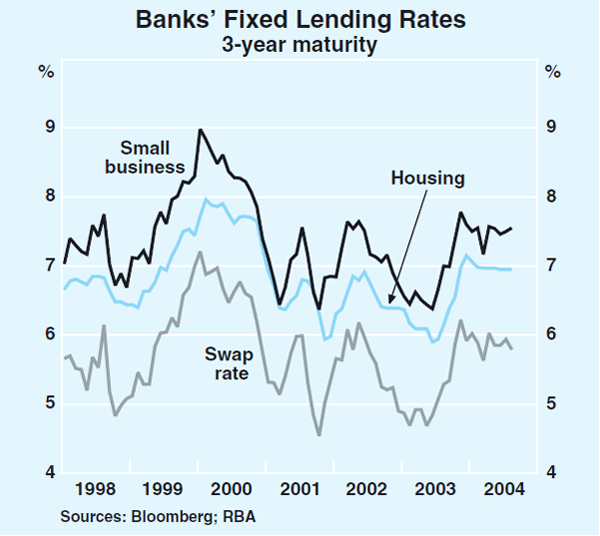
Demand for fixed-rate housing loans has continued to moderate since late 2003, suggesting that households may have become less concerned about the risk of rising interest rates. The share of new owner-occupier housing loans taken out at fixed rates declined from a peak of 15 per cent in November 2003, to 7 per cent in May, which is a little below the long-run average share (Graph 59). The average 3-year fixed housing loan rate has been broadly in line with the standard variable rate since the beginning of the year (Table 13).
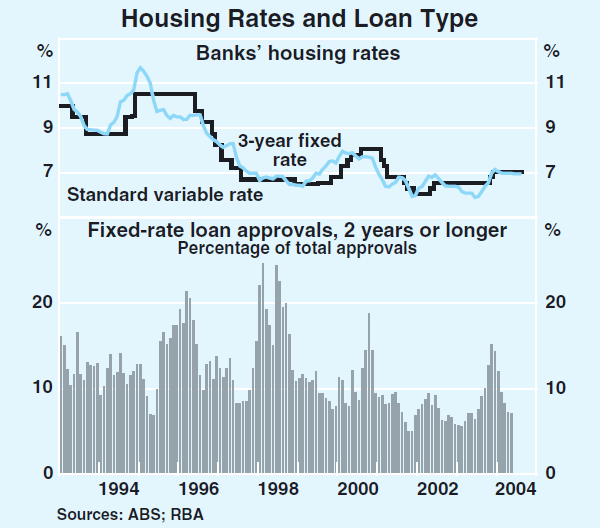
| Current level (4 August) |
|
|---|---|
| Variable rates | |
| Household | |
| Mortgages: | |
| – Standard variable | 7.05 |
| – Basic housing | 6.50 |
| – Mortgage managers | 6.70 |
| Personal lending: | |
| – Residential security | 7.20 |
| – Credit cards | 16.45 |
| Small business | |
| Residential security: | |
| – Overdraft | 7.95 |
| – Term loan | 7.25 |
| Other security: | |
| – Overdraft | 8.85 |
| – Term loan | 7.85 |
| Large business | |
| – Overdraft | 8.85 |
| Fixed rates (3 years) | |
| – Housing | 6.95 |
| – Small business | 7.55 |
| – Swap rate | 5.80 |
|
Source: RBA |
|
Equity prices
Australian share prices have risen by 4 per cent since the time of the previous Statement (Graphs 60 and 61). The ASX 200 index reached a new record high in early July but has since fallen slightly. In contrast, US and world equity prices have fallen slightly since the last Statement and remain almost 30 per cent below their March 2000 record highs. The strength in the Australian share market since early 2003 has contributed to a pick-up in margin lending (see Box C).
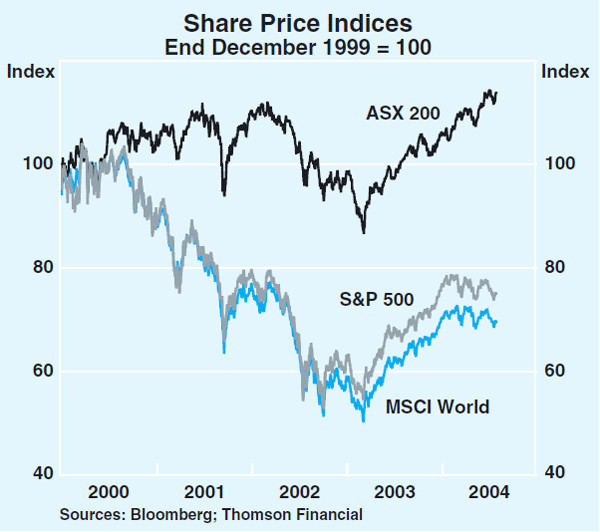
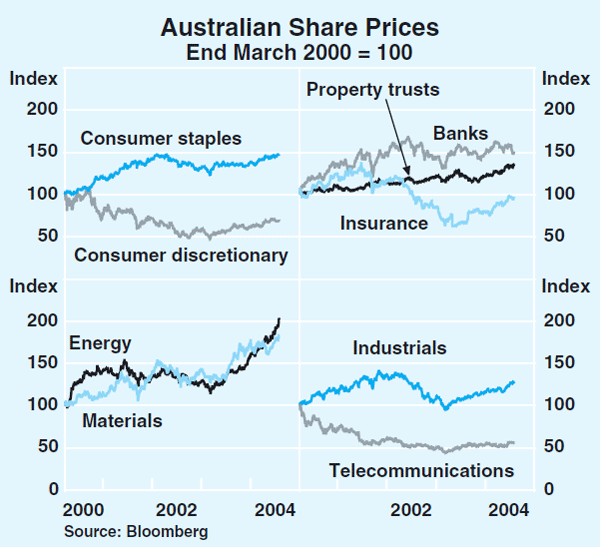
All of the 10 sectors in the ASX 200 have risen in the period since the previous Statement, with each having outperformed its global counterpart (Table 14). The materials sector has risen by 12 per cent over the period, buoyed by rising metals prices in part because of reduced concerns about a significant growth deceleration in China. The energy sector has also continued to outperform the broader share market, with higher oil prices contributing to a 15 per cent rise in energy sector share prices.
| GICS sector | ASX 200 |
MSCI World |
|---|---|---|
| Consumer discretionary | 2 | −4 |
| Consumer staples | 1 | −4 |
| Energy | 15 | 6 |
| Financials | 1 | −2 |
| Health care | 10 | −5 |
| Industrials | 7 | 2 |
| Information technology | 4 | −5 |
| Materials | 12 | 3 |
| Telecommunication services | 5 | −4 |
| Utilities | 10 | 4 |
| Composite | 4 | −2 |
|
Sources: Bloomberg; Thomson Financial |
||
Financing activity
Debt markets
Australian non-government entities issued $42 billion of bonds in the June quarter, close to the record $44 billion gross issuance seen in the March quarter. Financial institutions continued to issue large amounts, particularly in offshore markets (Table 15). Asset-backed issuance eased to $16 billion in the June quarter, from $21 billion in the March quarter, but remained strong by historical standards. The decline in asset-backed issuance primarily reflected lower issuance of residential mortgage-backed securities (RMBS) by traditional mortgage lenders (banks, building societies and credit unions); mortgage originators issued more RMBS than in the March quarter.
| Sector | 2001 | 2002 | 2003 | 2004 | ||
|---|---|---|---|---|---|---|
| March quarter |
June quarter |
July | ||||
| Bond issues by Australian entities | ||||||
| Onshore | ||||||
| Financial institutions | 6.0 | 7.4 | 9.8 | 2.5 | 4.0 | 0.1 |
| Non-financial corporates | 5.9 | 7.6 | 4.9 | 0.9 | 0.9 | 0.4 |
| Asset-backed | 15.0 | 19.3 | 21.2 | 6.0 | 7.8 | 1.9 |
| Total | 26.9 | 34.3 | 35.9 | 9.4 | 12.7 | 2.4 |
| Offshore | ||||||
| Financial institutions | 29.3 | 31.8 | 49.6 | 17.8 | 19.5 | 7.8 |
| Non-financial corporates | 6.8 | 7.5 | 14.5 | 1.5 | 1.9 | 2.0 |
| Asset-backed | 14.3 | 16.5 | 24.0 | 15.1 | 7.9 | 0.0 |
| Total | 50.4 | 55.9 | 88.0 | 34.4 | 29.3 | 9.8 |
| Total | 77.3 | 90.2 | 123.9 | 43.8 | 42.0 | 12.1 |
| A$ bond issues by non-resident entities | ||||||
| Onshore | 7.8 | 3.1 | 7.1 | 8.7 | 4.6 | 0.6 |
| Offshore | 4.3 | 17.3 | 24.4 | 5.5 | 3.3 | 0.7 |
| Total | 12.1 | 20.4 | 31.5 | 14.0 | 7.9 | 1.3 |
|
Source: RBA |
||||||
Issuance by non-financial institutions remained subdued. At a bit over $5 billion, non-financials' issuance in the first half of 2004 was less than half that seen in the same period of 2003. However, this weakness has been mostly offset by stronger equity raisings (Graph 62).
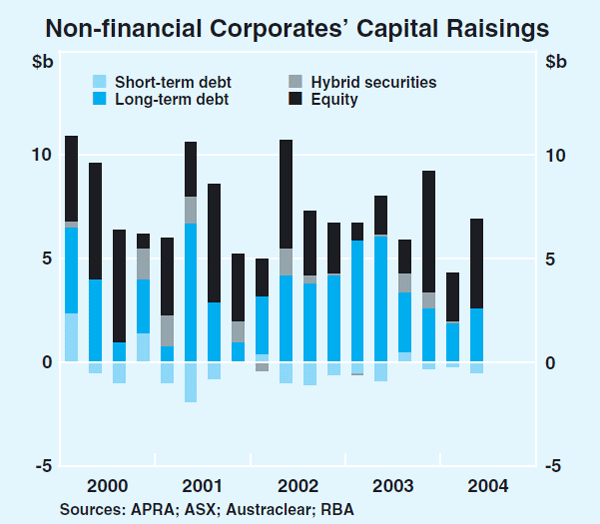
Non-residents issued $8 billion of Australian-dollar denominated bonds in the June quarter, markedly lower than issuance in the March quarter, but still a large amount by historical standards (Graph 63). The issuance, by both financial institutions and supranational/government entities, was split fairly evenly between the domestic and offshore markets.
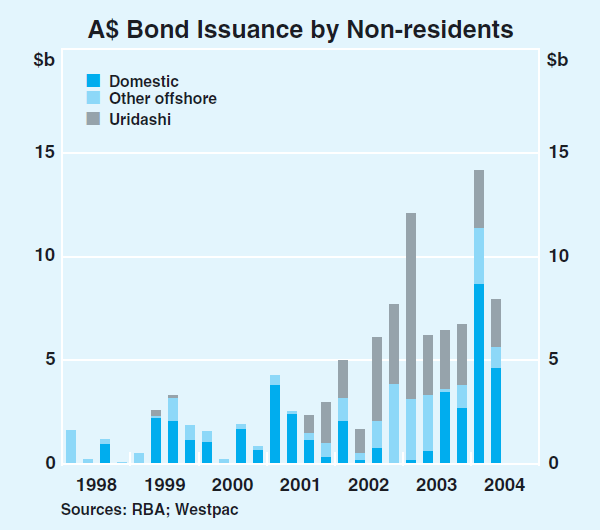
Total issuance of bonds in the domestic market by all non-government borrowers (including non-residents) was $35 billion in the first half of 2004, substantially more than in any previous six-month period. Outstandings of non-government debt have increased by $13 billion to $164 billion, while the amounts outstanding of both Commonwealth Government bonds ($53 billion) and state government bonds ($54 billion) are little changed (Graph 64).

Equity raisings
Net equity raisings totalled $5.3 billion in the June quarter (Graph 65). Equity raised through IPOs in the quarter was particularly strong at $3.5 billion, and was second only to the December quarter of 2003. Around 35 companies listed in the quarter, with half of these from the materials and consumer discretionary sectors. Just two companies accounted for more than half of the value of equity raised through IPOs during the quarter, with the median amount raised being $12 million. Box D outlines some of the reasons for the recent strength in IPO activity. The strength of total equity raisings was tempered to some extent by raisings other than IPOs being below the average levels of recent years, and buybacks being above average.
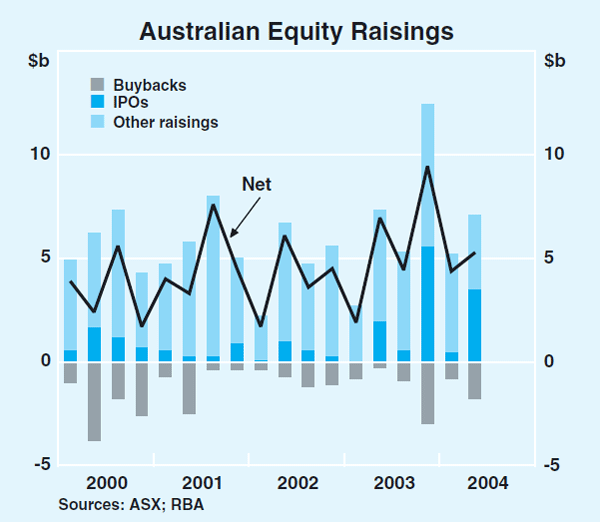
Box C: Recent Developments in Margin Lending
Following relatively subdued growth over 2002/03, margin lending for equities and managed funds has picked up strongly over the past year; the level of margin debt outstanding (including protected financing) increased by 23 per cent over the year to June 2004, to reach $13.7 billion (Graph C1).[1] The pick-up in margin lending has been supported by the recovery in the share market, and may also reflect a decline in the appeal of property investment. Despite its recent strength, however, margin lending is still small compared with other forms of household borrowing, accounting for around 13 per cent of non-housing personal debt and 2 per cent of total household debt.
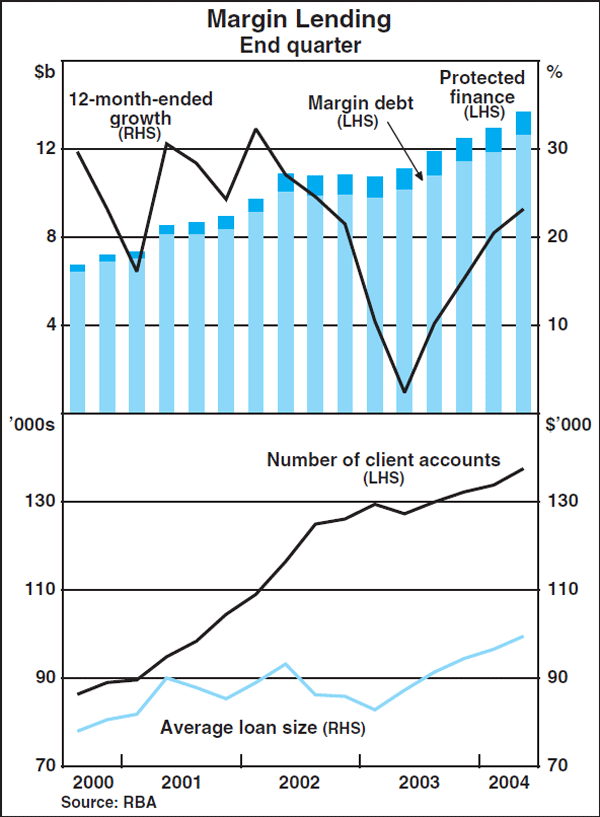
Much of the recent pick-up in margin lending is likely to have reflected increases in existing borrowers' debt levels, with the number of margin loan accounts rising more modestly over the period. As such, the average size of outstanding margin loans has increased markedly, from around $83,000 in March 2003 to almost $100,000 at present, which is the highest level since the survey's inception in 1999.
Although the level of margin debt has increased strongly over the past year, the value of assets securing the loans has risen more rapidly – helped by the strong performance of the Australian share market – and as a result the average leverage ratio has fallen to around its lowest level in two years (Graph C2). Average credit limit usage has also remained low during the past year. Together, these observations suggest that borrowers are, on average, being relatively cautious, perhaps mindful of earlier episodes of higher market volatility and more frequent margin calls.
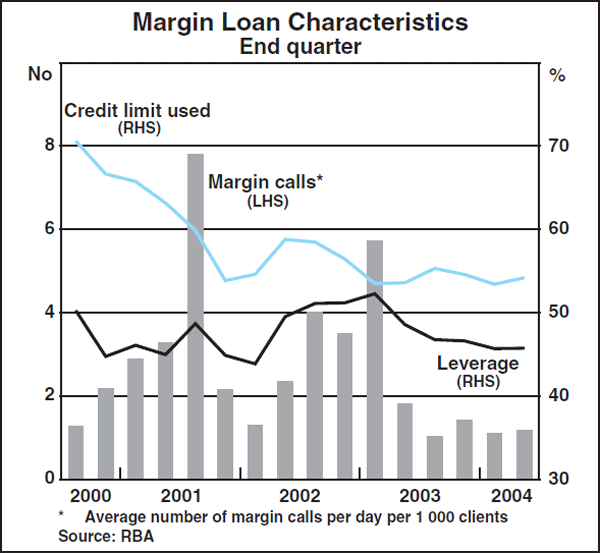
As at June 2004, direct holdings of Australian shares comprised 70 per cent of the assets underlying margin loans (up from around 60 per cent in 2002), with managed fund investments making up most of the remainder. Around 68 per cent of outstanding margin debt was at variable interest rates, with the predominant rate currently around 8 per cent. The remaining debt is at fixed rates with most of this in the form of loans on which interest has been prepaid (usually up to 12 months in advance). As interest on margin loans is tax deductible, prepayment enables investors to bring forward the tax deduction – which may be particularly beneficial near the end of the financial year – and typically also entitles them to a small discount on the usual fixed rate. Reflecting these possible advantages, growth in margin lending tends to be higher, and a greater share of new loans have interest prepaid, in the June quarter of each year.
The recent strength in margin lending may also reflect competition between margin lenders which has seen the introduction of new products and additional features and flexibility in existing products. For example, while it has always been possible for people to finance share investments by borrowing against their houses, some margin lenders have recently begun offering products which effectively combine a home equity loan with a traditional margin loan. While these products may provide a further means for investors to diversify their asset base, by increasing the overall leverage of the investment they have the potential to magnify both gains and losses, and hence present a greater risk to investors. Many margin loan providers now also offer geared savings plans, where the borrower's own periodic savings are combined with increases in the margin loan to purchase additional shares or managed fund investments.
Box D: Initial Public Offering (IPO) Activity in Australia
The past year has seen a relatively high level of IPO activity on the Australian Stock Exchange (ASX). Since end June 2003, more new companies have listed on the ASX than during any previous 12-month period aside from the ‘dot.com’ related wave of IPO activity during late 1999 and 2000 (Graph D1). In terms of the value of equity capital raised through primary offerings (excluding privatisations and demutualisations), the past financial year has been the strongest on record.
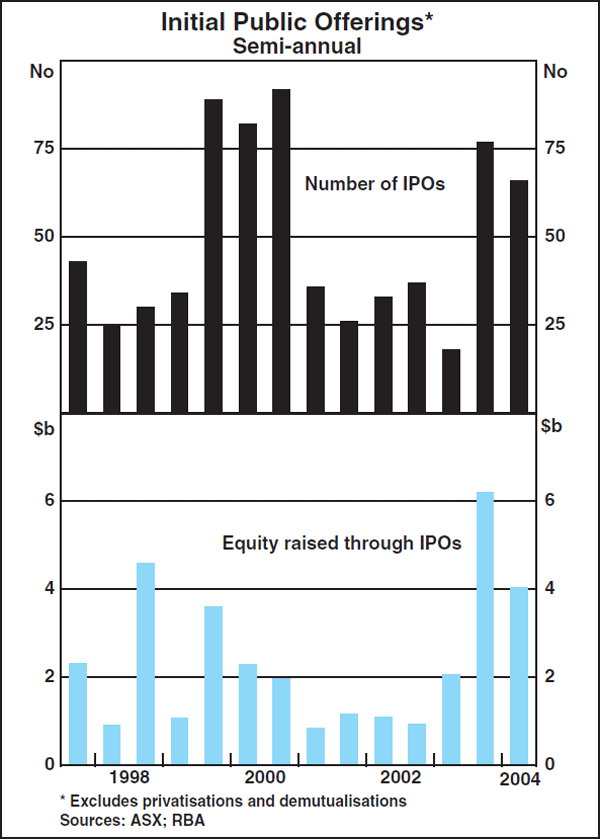
The increase in IPO activity in late 1999 and 2000 corresponded with the height of the dot.com boom (Graph D2). The jump in the number of IPOs during this period was primarily due to IT and IT-related IPOs and came after IT share prices more than doubled in the first half of 1999. IT share prices peaked in March 2000 at almost eight times their end 1998 level and fell sharply thereafter, reverting to their end 1998 level by end 2002. The drop-off in IPO activity was just as pronounced, with very few IT companies having listed since 2001.
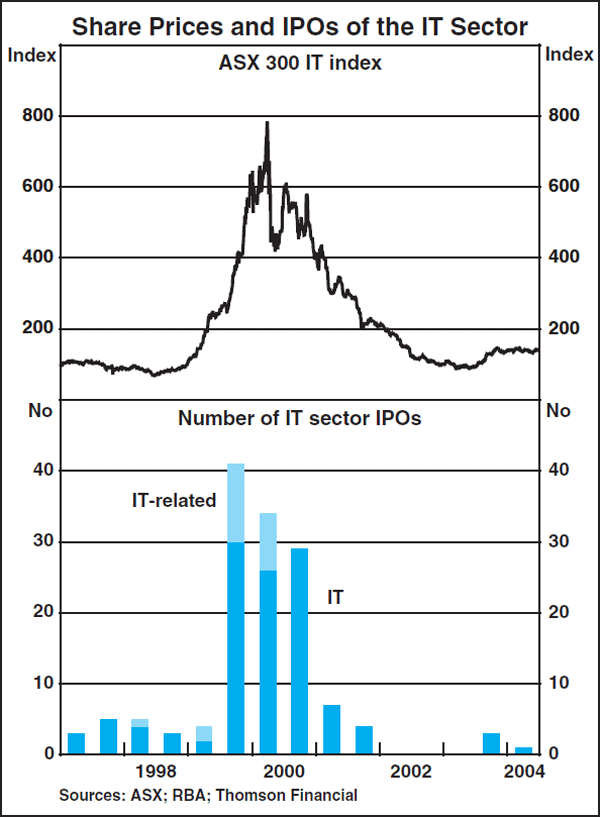
The pick-up in IPO activity in the second half of 2003 corresponded with a turnaround in global equity markets and a more optimistic global economic outlook. The increase in listings was in part driven by listings of materials companies, particularly mining companies (Graph D3). The strength in mining IPOs reflected strong increases in US dollar commodity prices and in demand from China, and significant increases in resource company share prices. Other sectors that have participated in the recent wave of IPOs include the health care, financials (primarily property trusts and listed investment companies) and consumer discretionary sectors.
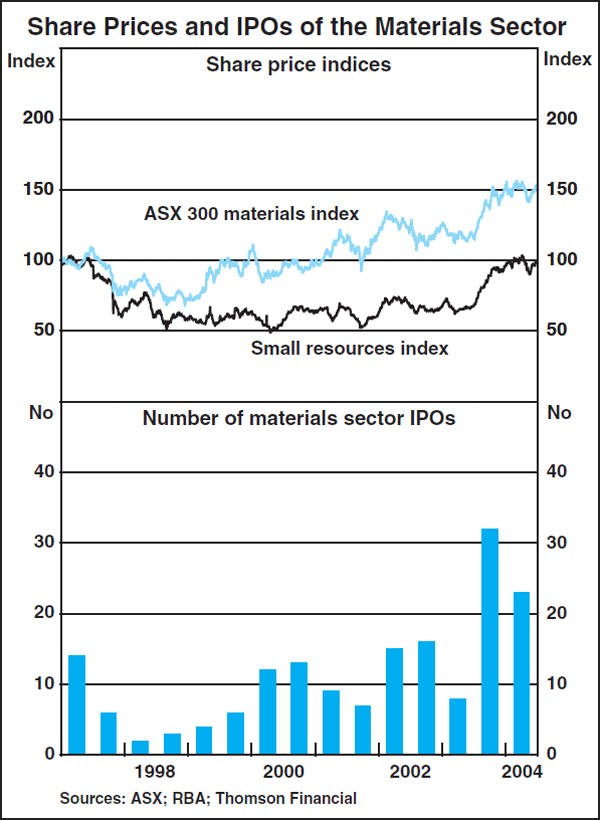
As with IT companies during the dot.com boom, mining companies have accounted for more than one-third of total listings during the past year. However, the growth in the number of listed mining companies is nowhere near as pronounced: the 54 recently listed mining companies comprise around 15 per cent by number of all listed mining companies and a very small share of their market capitalisation. Moreover, the rise in resource companies' share prices, although strong, has been much less than that of IT stocks during the dot.com boom.
Many of the recently-listed mining stocks are start-up companies with little or no earnings history, and some are not currently profitable. The speculative nature of some of these companies is further highlighted by the wide variation in the performance of their share prices since listing: the prices of several have almost tripled, while others have lost around two-thirds of their value. By end June, the median return on issue price for mining companies that have listed during the past year was −19 per cent and the weighted average return (based on the amount raised in the IPO) was −4 per cent. Less than one-quarter of new mining company listings have outperformed the All Ordinaries index since their issue. This is somewhat below the historical performance of mining IPOs.
It should be noted, however, that the share price performance of other companies that have listed in the past year has also been varied (Graph D4). By end June, the median non-mining company was 1 per cent higher than its issue price, and the weighted average return on issue price was 6 per cent. About half of recently-listed non-mining companies have outperformed the All Ordinaries index since listing. This is in line with the average post-listing performance.
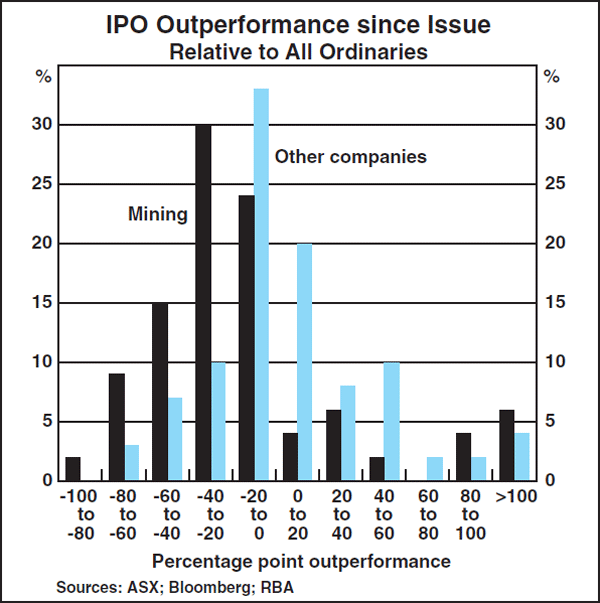
Financial Conditions
The cash rate has remained at 5.25 per cent since the increases of 25 basis points each in November and December last year. It is now 100 basis points above its trough in 2001 and 2002, but the current level remains below its average over the past decade. Taken together with the continued strong borrowing activity of both households and businesses, this suggests that monetary policy is still mildly accommodative.
Growth in total credit slowed in the first half of 2004, with annualised growth of 13 per cent over the six months to June, compared with a peak rate of 18 per cent over the second half of 2003 (Table 16). This slowing is mostly accounted for by business credit.
| Six-month-annualised | Year-ended June 2004 |
||
|---|---|---|---|
| December 2003 | June 2004 | ||
| Total credit | 18.1 | 12.9 | 15.5 |
| Household | 21.2 | 18.0 | 19.6 |
| – Housing | 22.6 | 18.4 | 20.5 |
| – Personal | 13.5 | 16.2 | 14.8 |
| Business | 13.1 | 4.3 | 8.6 |
| Broad money | 14.2 | 8.0 | 11.1 |
|
Source: RBA |
|||
The pace of household credit growth has moderated a little, with annualised growth of 18 per cent over the half-year to June, compared with a rate of 21¼ per cent over the previous half-year. However, this rate of growth is still unsustainable relative to growth in households' capacity to service the debt, which is mainly determined by growth in household incomes. The continued strength is due to growth in both housing credit and in other forms of personal credit, including margin lending and drawdowns on home equity loans for non-housing purposes (see ‘Box C’ for more discussion on margin lending). Borrowing for housing has slowed modestly from the very high rates of the second half of last year, but it remains very strong, with annualised growth of 18½ per cent over the past half-year. This continued strong growth is in line with housing loan approvals, which have also come down somewhat from the peak of $15 billion per month in October 2003, but then stabilised in the first five months of 2004 at around $12½ billion per month. Loan approvals to investors have fallen more noticeably than those to owner-occupiers, but lending to investors still remains high by historical standards (see the chapter on ‘Domestic Economic Conditions’ for a more detailed discussion). Given that the level of loan approvals tends to lead credit growth, further falls in loan approvals would have to occur before housing credit growth could be expected to return to a more sustainable pace.
Growth in business credit has been lower than that for household credit, and quite volatile. After contracting over the three months to March, business credit grew at a solid pace in the June quarter, bringing its annual growth rate to around 8½ per cent over the year to June. Overall, firms appear to continue to have ready access to finance from both internal and external sources.
The continued strength in borrowing suggests that households and businesses do not find current financial conditions to be restrictive, notwithstanding the increases in interest rates late last year. Along with the cash rate, other variable and fixed lending rates are still below their averages of the past decade, and have remained largely unchanged over 2004 to date (Graph 66).
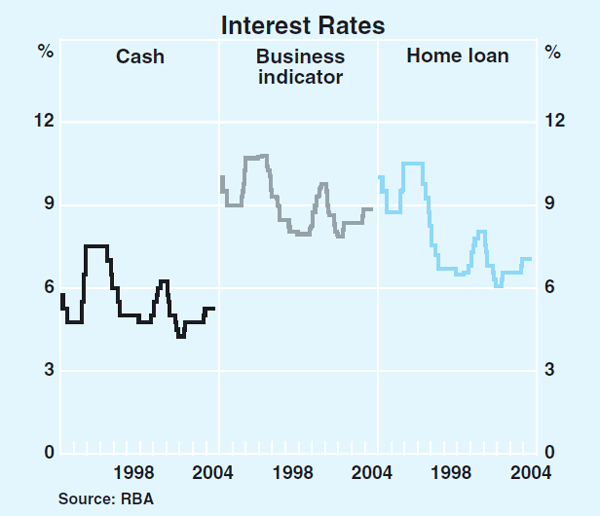
Ten-year bond yields in early August were around 25 basis points below the level at the time of the last Statement (Graph 67). The slope of the yield curve – as measured by the yield on 10-year bonds less the cash rate – was 45 basis points in early August, which is less steep than implied by the average differential from 1995 of around 95 basis points. This measure can be interpreted as an indicator of the stance of policy, and might suggest that policy is less expansionary than indicated by growth in credit or the level of borrowing rates. However, it is likely that it is being held down by the influence on Australian bond yields of foreign yields, which remain at low levels due to the accommodative policy in the major economies.
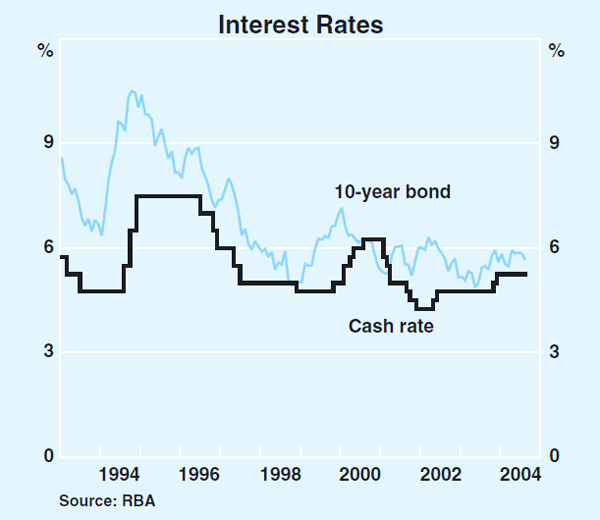
As of early August, the Australian dollar had depreciated by around 3 per cent on a trade-weighted basis since the time of the May Statement, to be around 9 per cent below its February peak. Although the real exchange rate remains well above its post-float average, this coincides with a number of factors that have been favourable to the tradables sector. The terms of trade have grown strongly in recent quarters, to be at their highest level since the mid 1970s (Graph 68). The strengthening in global demand is also contributing to a more favourable environment for Australia's exporters.
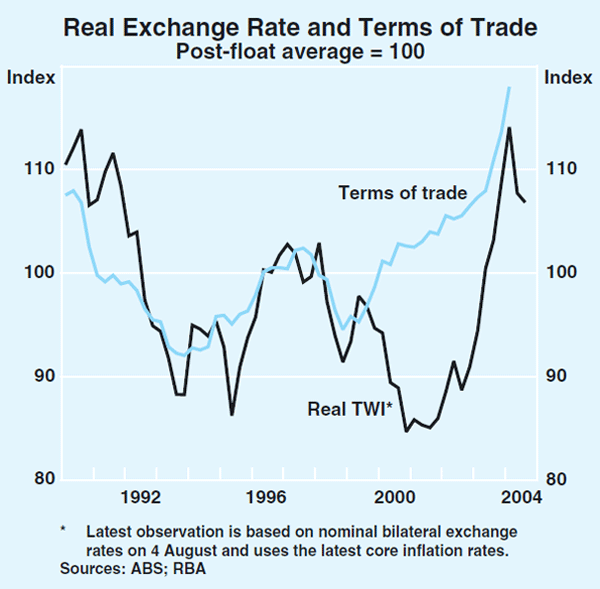
Inflation Trends and Prospects
Recent developments in inflation
The Consumer Price Index rose by 0.5 per cent in the June quarter to be 2.5 per cent higher over the year (Graph 69). The profile for inflation over the past year has, however, been affected by fluctuations in petrol prices; these depressed the CPI in the June quarter 2003 but have subsequently risen strongly. Consequently, as that quarter has dropped out of the current annual figure, the year-ended rate has increased. Excluding petrol prices, the CPI rose by 2.1 per cent over the year (Table 17). The Bank's assessment, based on a range of different measures, is that the annual rate of underlying inflation is still running at around 2 per cent, or a little above.
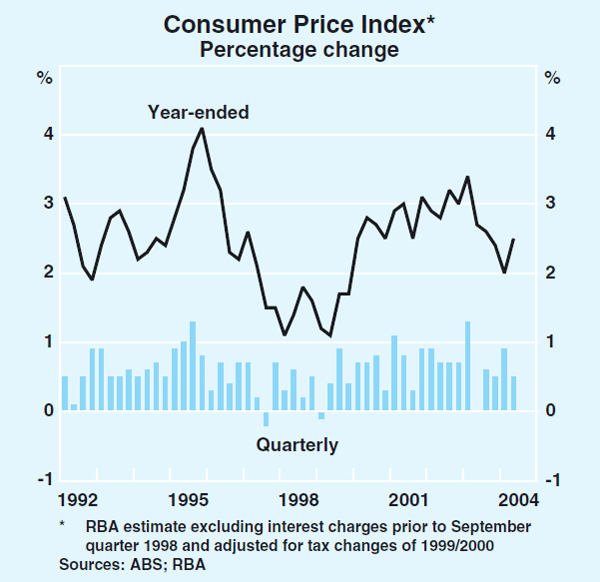
| Quarterly | Year-ended | ||||
|---|---|---|---|---|---|
| March 2004 | June 2004 | March 2004 | June 2004 | ||
| CPI | 0.9 | 0.5 | 2.0 | 2.5 | |
| – CPI (less petrol) | 0.8 | 0.2 | 2.3 | 2.1 | |
| – Tradables | 0.6 | 0.2 | −0.5 | 0.5 | |
| – Tradables (excluding petrol & food) | −0.5 | 0.2 | −1.3 | −1.4 | |
| – Non-tradables | 1.1 | 0.7 | 4.1 | 4.1 | |
| Underlying measures | |||||
| Weighted median | 0.7 | 0.6 | 2.3 | 2.3 | |
| Trimmed mean | 0.6 | 0.5 | 2.1 | 2.1 | |
| CPI excluding volatile items(a) | 0.5 | 0.5 | 2.1 | 1.9 | |
| Market goods and services excluding volatile items |
0.0 | 0.4 | 1.3 | 1.2 | |
|
(a) Volatile items are fruit, vegetables and automotive fuel Sources: ABS; RBA |
|||||
The divergence between tradable and non-tradable inflation persists (Graph 70). However, this gap is likely to have passed its maximum, with the effect of the appreciation of 2002–2003 beginning to wane. Following a run of sizeable falls, prices of tradables (excluding petrol and food) rose by 0.2 per cent in the quarter, though they fell over the year by 1.4 per cent.
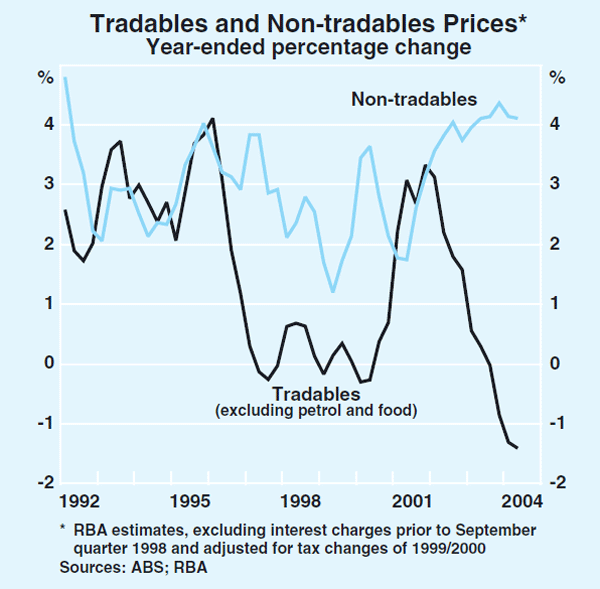
Inflation of non-tradable items remained quite firm. Overall, the price of non-tradables rose by 0.7 per cent in the June quarter and by 4.1 per cent over the year. Housing costs continued to rise noticeably, making one of the largest contributions to growth in non-tradables prices. House purchase costs rose by 1.4 per cent in the quarter and by 5.3 per cent over the year. Liaison suggests that these increases are being driven in part by labour shortages and higher materials costs. The latest quarterly increase in the price of non-tradables was also partly due to increases in the cost of private health insurance, which caused overall health prices to rise by 3.1 per cent in the quarter, and by 6.6 per cent over the year.
Producer prices
Indices of producer prices similarly show that the sharp contrast between domestic and external sources of inflation diminished slightly in the June quarter. While domestically sourced inflation remained firm, the depreciation between March and June contributed to an increase in imported producer prices for the first time since late 2002, partly reversing the declines that had been evident for the past eighteen months (Graph 71). In addition, higher crude oil prices also induced rises in producer prices at each stage of production, with costs rising for firms that use either oil or oil-intensive inputs to production. Reflecting these developments, some upstream inflationary pressures have emerged, with prices at preliminary and intermediate stages of production increasing sharply in the quarter (Table 18).
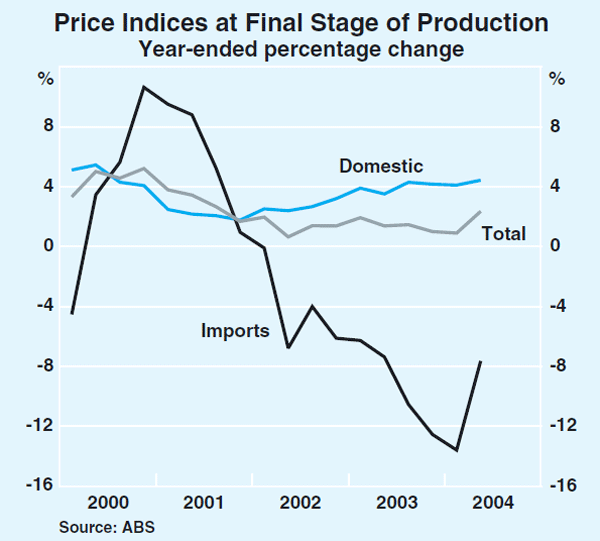
| June quarter 2004 |
Year to June quarter 2004 |
|
|---|---|---|
| Preliminary | 1.9 | 1.0 |
| Domestic | 1.2 | 1.7 |
| Imported | 8.3 | −3.0 |
| Excluding oil | 1.2 | 0.6 |
| Intermediate | 1.4 | 0.4 |
| Domestic | 0.8 | 1.4 |
| Imported | 6.1 | −5.4 |
| Excluding oil | 1.0 | 0.1 |
| Final(a) | 1.1 | 2.3 |
| Domestic | 0.8 | 4.4 |
| Imported | 2.3 | −7.6 |
| Excluding oil | 0.9 | 1.9 |
|
(a) Excluding exports Source: ABS |
||
While oil prices played a prominent role, at the final stage of production, construction costs made the largest contribution to prices growth. Liaison suggests that pressures on construction costs remain significant. The Davis Langdon Tender Price Index – which prices a fixed basket of labour and material inputs typically used in commercial and apartment construction – confirms this, though pressures are now abating in some regions, particularly Melbourne (Graph 72).
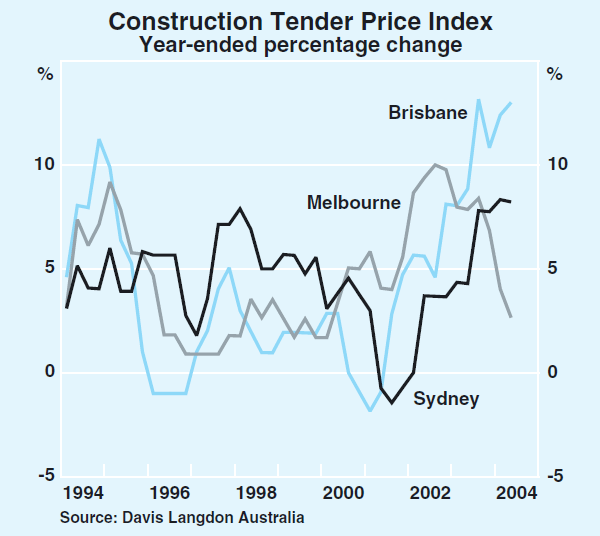
Labour costs
The wage cost index (WCI) for total hourly pay increased by 0.7 per cent in the March quarter, to be 3.5 per cent higher than a year earlier (Graph 73). This outcome for the WCI was lower than expected, though the year-ended rate of increase is still higher than the average for this series. The March quarter result was held down by a slowing in public-sector wages growth in the quarter, as the effects of some earlier amendments to state government awards abated, and by benign wage outcomes in several large industries, such as manufacturing and property & business services (Table 19). Inclusive of bonus payments, however, a number of industries have recorded more buoyant wages growth, particularly those where labour market conditions are tight. Furthermore, liaison suggests that bonus payments are becoming more prevalent.

| Industry | Share of wage bill Per cent | December quarter 2003 |
March quarter 2004 |
|---|---|---|---|
| Manufacturing | 15.8 | 3.6 | 3.4 |
| Property & business services | 12.1 | 3.7 | 3.5 |
| Health & community services | 10.0 | 5.3 | 4.1 |
| Education | 8.8 | 3.5 | 3.8 |
| Retail trade | 8.8 | 3.1 | 3.1 |
| Government admin. & defense | 6.6 | 5.1 | 4.5 |
| Finance & insurance | 6.5 | 3.1 | 3.2 |
| Other | 31.4 | 3.6 | 3.5 |
| Total (seasonally adjusted) | 100.0 | 3.7 | 3.5 |
|
Source: ABS |
|||
Most other labour cost indicators point to a continuance of wages growth around current rates or hint at a modest pick-up. According to the Department of Employment and Workplace Relations, the average annualised wage increase certified in new enterprise bargaining agreements (EBAs) edged up to 4.1 per cent in the March quarter from 4.0 per cent in December, with the increase mainly due to higher wage outcomes in the public sector; outcomes in the private sector eased slightly in the quarter. The average wage increase for the stock of existing agreements in March remained at 3.9 per cent. Business surveys also report firm wages growth. The NAB Quarterly Business Survey recorded 0.6 per cent growth in labour costs in the June quarter and it foreshadows a similar pace in the September quarter. Year-ended growth in labour costs is now around 3 per cent – slightly stronger than recorded earlier in the year. In contrast, after increasing steadily since early 2003, the Mercer Quarterly Salary Review reported that annual growth in the base salaries of executives slowed in the June quarter to 4.3 per cent.
While growth in standard measures of aggregate earnings remains reasonably well contained, these measures do not include the rates paid to subcontractors. For some industries where use of subcontractors is common, the current firmness in the labour market is being reflected in more pronounced growth in labour costs. Furthermore, these labour cost pressures are becoming more prominent in both the goods and services sectors and are extending to less-skilled workers.
Inflation expectations
Most measures of inflation expectations suggest that observers expect mild inflation outcomes in the near term before a modest increase in inflation over the next two years, with some convergence in views about this longer-term outlook now evident (Table 20). Financial market economists surveyed by the Bank have lowered slightly their median expectation of inflation for the year ahead – given that the June quarter CPI was slightly lower than anticipated by the markets – while they expect inflation to rise from current rates over a longer horizon. Union officials continue to predict a more stable profile for inflation than market economists; while they have revised up their near-term inflation expectations a little, they see no additional increase in inflation beyond the coming year. The inflation expectations of union officials do, however, remain higher than those of financial market economists over the whole forecast period.
| Year to June 2005 | Year to June 2006 | ||||
|---|---|---|---|---|---|
| February 2004 |
May 2004 |
August 2004 |
August 2004 |
||
| Market economists(a) | 2.4 | 2.5 | 2.4 | 2.7 | |
| Union officials(b) | 3.0 | 2.9 | 3.0 | 3.0 | |
| (a) RBA survey (b) ACIRRT survey |
|||||
The various business surveys present a consistent view that inflation expectations have risen from their low base, though they remain below long-run average levels. Both the quarterly NAB business survey and the ACCI-Westpac survey of manufacturers reported that inflationary pressures have increased in the June quarter, with firms reporting a rise in actual and expected selling prices. Manufacturers surveyed by the AIG also indicated that selling prices rose significantly in the June quarter, with these increases attributed to higher costs for fuel and other commodities.
In contrast, among consumers, inflation expectations are little changed in recent months, despite the prominence of news about higher oil prices. The Melbourne Institute reported that the median expectation for consumer price inflation over the coming year rose marginally to 4.4 per cent in July, unwinding the previous month's decline (Graph 74). Looking through the volatility in this series, expectations have been stable in recent years.

Similarly, the expectations of financial market participants are currently little changed from the time of the last Statement. Longer-term expectations, as measured by the difference between nominal and indexed 10-year bond yields, rose somewhat in the June quarter, before declining back to around 2.5 per cent over July. These movements appear, in part, to be a response of nominal bond yields to developments in world bond markets rather than signalling a lack of change in the financial market's view of the inflation outlook.
Inflation outlook
The Bank's assessment is that underlying inflation remains a little above 2 per cent. The overall decline in inflation from its peak early last year has reflected the ongoing effects of the large appreciation of 2002–2003. These effects are likely to continue to hold down inflation in the near term, so that underlying inflation is likely to remain close to 2 per cent over the remainder of this year. However, as this disinflationary impulse from the earlier appreciation dissipates, the inflation rate is expected to increase to around 2½ per cent by the end of 2005, and could subsequently go higher if the current strength in the domestically sourced component of inflation persists.
CPI inflation will probably follow a slightly different profile. In the near term, prevailing high oil prices and rising prices for some publicly administered items will keep the headline rate of inflation above most underlying measures by up to ½ percentage point. This gap should gradually narrow until the middle of next year, as the impetus from oil prices is expected to abate and tariffs are lowered on certain items. From the middle of next year, it is likely that both the CPI and underlying inflation will follow similar paths, and move higher together.
One risk to this outlook is the price of oil. The Bank's forecast is based on an assumption that the oil price gradually falls to US$32 per barrel (or around its five-year average in SDR terms). The marked strengthening of the world economy and recent disruptions to global oil supply suggest that this reversion may not occur, or may be slower than anticipated. If that proves to be the case, fuel prices in Australia would persist at a higher level. There is also the broader risk that a tightening oil market could induce higher world prices and so put upward pressure on the prices of various imported goods and services, possibly altering inflation expectations.
The domestically focused risks to the inflation outlook remain slightly tilted to the upside. Demand pressures could develop in a way that places upward pressure on a range of domestic prices and costs. Labour market conditions remain quite firm, and there is a possibility that continued strength in demand for labour could push wages growth above that currently envisaged. However, to date, wage pressures have been well contained, and could indicate a less pronounced sensitivity of wages growth to demand conditions than suggested by historical experience.
Footnote
Based on analysis of earlier data, the pattern of upward revisions appears to exist for all capitals, reflecting a tendency for settlement and recording lags to be longer for more expensive properties. [1]
Footnotes Box C
See Box C in the May 2000 Statement for a description of margin lending. The data on margin lending are obtained from the RBA's quarterly survey of margin lenders, published in Bulletin Table D.10. [c1]